Paul van Yperen's Blog, page 136
January 20, 2022
In memory of Gaspard Ulliel (1984-2022): Un long dimanche de fian��ailles (2004)
On Wednesday 19 January 2022, French actor Gaspard Ulliel (1984) died in Grenoble, France. The Cesar-winning star of Un long dimanche de fian��ailles/A Very Long Engagement (2004) and Hannibal Rising (2007) was involved in a skiing accident in the Alps. He was only 37. In his memory, we updated our post on his best-known film, the beautiful Un long dimanche de fian��ailles/A Very Long Engagement (Jean-Pierre Jeunet, 2004).
Un long dimanche de fian��ailles (2004) is a French romantic war film, co-written and directed by Jean-Pierre Jeunet and starring Audrey Tautou and Gaspard Ulliel. It is a fictional tale about a young woman's desperate search for her fiance who might have been killed during World War I. It was based on a novel of the same name, written by Sebastien Japrisot, first published in 1991.
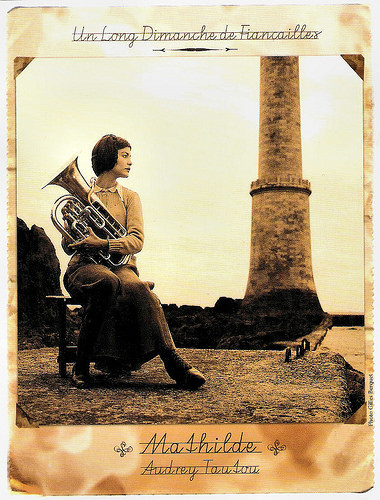
French postcard by Warner Bros, France / Tapioca Films / TF1 Films Production. Poster by Laurent Lufroy. Photo: Bruno Calvo. Publicity still for Un long dimanche de fian��ailles/A Very Long Engagement (Jean-Pierre Jeunet, 2004) with Audrey Tautou as Mathilde.
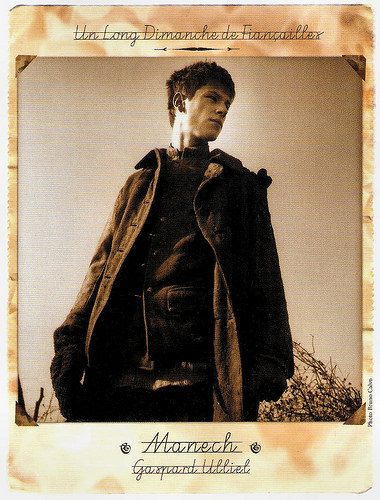
French postcard by Warner Bros, France / Tapioca Films / TF1 Films Production. Poster by Laurent Lufroy. Photo: Bruno Calvo. Publicity still for Un long dimanche de fian��ailles/A Very Long Engagement (Jean-Pierre Jeunet, 2004) with Gaspard Ulliel as Manech.
Manech's Marrying Mathilde
Un long dimanche de fian��ailles/A Very Long Engagement (2004) tells the romantic story of Mathilde (Audrey Tautou), a young woman who relentlessly searches for her fiance Manech (Gaspard Ulliel) during World War I.
Near the Somme, five French soldiers are convicted of self-mutilation in order to escape military service. They are condemned to face near-certain death in the no man's land between the French and German trench lines. It appears that all of them were killed in a subsequent battle.
Mathilde, the fiancee of one of the soldiers, refuses to give up hope and begins to uncover clues as to what actually took place on the battlefield. Her task is not made any easier for her due to a bout with polio as a child. She is all the while driven by the constant reminder of what her fiance had carved into one of the bells of the church near their home, MMM for Manech's Marrying Mathilde (actually in French: Manech aime Mathilde = Manech Loves Mathilde).
With the help of a private investigator, she attempts to find out what happened to her fiance. Along the way, she discovers the brutally corrupt system used by the French government to deal with those who tried to escape the front. She also discovers the stories of the other men who were sentenced to the no man's land as a punishment.
The story is told both from the point of view of the fiancee in Paris and the French countryside���mostly Brittany���of the 1920s, and through flashbacks to the battlefield.
Eventually, Mathilde finds out her fiance is alive, but he suffers from amnesia. He fails to identify even his adoptive mother. Seeing Mathilde, Manech seems to be oblivious of her. However, he still expresses concern for her when he notices her polio-stricken legs, asking her "does it hurt when you walk ?" as he did when they first met. At this, Mathilde sits on the garden chair silently watching Manech with tears in her eyes and a smile on her lips.
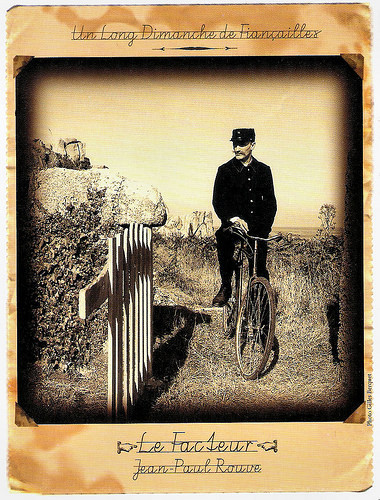
French postcard by Warner Bros, France / Tapioca Films / TF1 Films Production. Poster by Laurent Lufroy. Photo: Bruno Calvo. Publicity still for Un long dimanche de fian��ailles/A Very Long Engagement (Jean-Pierre Jeunet, 2004) with Jean-Paul Rouve as the mailman.
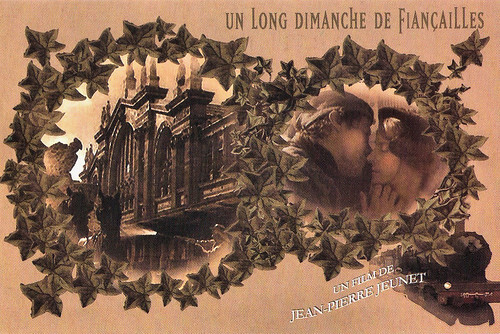
French postcard by Warner Bros, France / Tapioca Films / TF1 Films Production. Gaspard Ulliel and Audrey Tautou in Un long dimanche de fian��ailles/A Very Long Engagement (Jean-Pierre Jeunet, 2004).
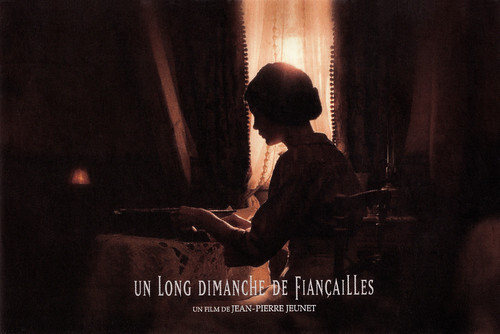
French postcard by Warner Bros, France / Tapioca Films / TF1 Films Production. Audrey Tautou on the English poster for Un long dimanche de fian��ailles/A Very Long Engagement (Jean-Pierre Jeunet, 2004).
A visual tour de force
Director Jean-Pierre Jeunet had a surprise smash with Am��lie (2001), featuring the expressive Audrey Tautou as a whimsical and charming girl-woman in search of love. In his follow-up film, Un long dimanche de fiancailles, Jeunet crafted a moving, often penetrating drama, set during the darkest days of World War I and its immediate aftermath.
Audrey Tautou returned and plays pretty but frail Mathilde, a loner separated from her peers by her disability. She becomes closest friends with Maneche (Gaspard Ulliel), the son of a lighthouse keeper. Late adolescence brings love and lust, commitment, and an engagement. And when Maneche does not return from the war, Mathilde searches fervently for him, steely faithful in a moving and believable way.
Ralph Michael Stein at IMDb : "her search takes her to cities and battlefields. With resort to a child's employment of magical thinking, she frequently whispers tests about what will happen in immediate, ordinary circumstances with one result 'proving' for her that Manech is still alive. Tautou makes this self-deception appealing and infinitely sad."
At AllMovie , Derek Armstrong reviews: "Jean-Pierre Jeunet's most sophisticated achievement to date, if not actually his best film, A Very Long Engagement marks the first instance of the director's trademark techniques applied to a story of historical consequence. In addition to possessing Jeunet's usual busy narration and array of interconnected characters, it's also a visual tour de force."
Un long dimanche de fiancailles was nominated for the Academy Award for Best Art Direction and the Academy Award for Best Cinematography at the Oscars. The film received five C��sars, the French equivalent of the Oscar. Marion Cotillard won the C��sar Award for Best Supporting Actress and Gaspard Ulliel the C��sar for Most Promising Actor.
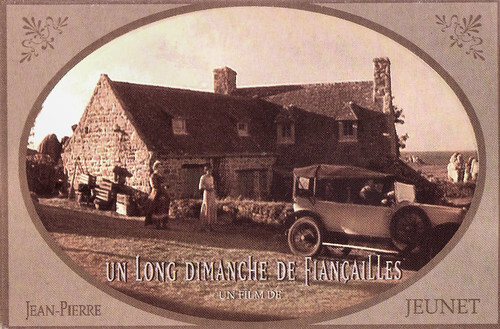
French postcard by Warner Bros, France / Tapioca Films / TF1 Films Production. Scene from Un long dimanche de fian��ailles/A Very Long Engagement (Jean-Pierre Jeunet, 2004).
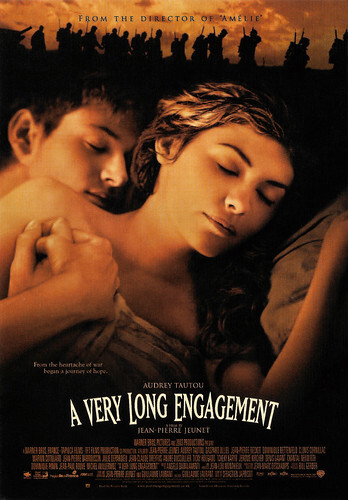
French postcard by Sonis, noo. C. 1586. Image: Warner Brothers. Gaspard Ulliel and Audrey Tautou on the English poster for Un long dimanche de fian��ailles/A Very Long Engagement (Jean-Pierre Jeunet, 2004).
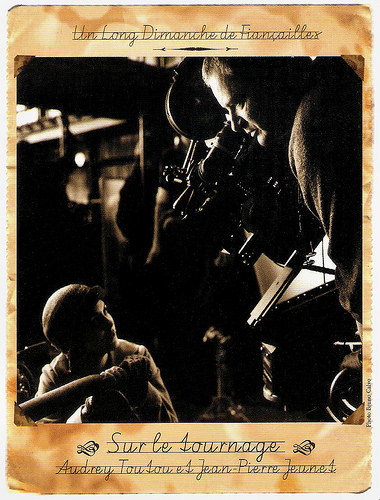
French postcard by Warner Bros, France / Tapioca Films / TF1 Films Production. Poster by Laurent Lufroy. Photo: Bruno Calvo. Publicity still for Un long dimanche de fian��ailles/A Very Long Engagement (Jean-Pierre Jeunet, 2004). Audrey Tautou and director Jean-Pierre Jeunet at the set.
Trailer. Source: Geschiedenis Beleven (YouTube).
Sources: Derek Armstrong (AllMovie), Ralph Michael Stein (IMDb), Wikipedia, and IMDb.
Un long dimanche de fian��ailles (2004) is a French romantic war film, co-written and directed by Jean-Pierre Jeunet and starring Audrey Tautou and Gaspard Ulliel. It is a fictional tale about a young woman's desperate search for her fiance who might have been killed during World War I. It was based on a novel of the same name, written by Sebastien Japrisot, first published in 1991.

French postcard by Warner Bros, France / Tapioca Films / TF1 Films Production. Poster by Laurent Lufroy. Photo: Bruno Calvo. Publicity still for Un long dimanche de fian��ailles/A Very Long Engagement (Jean-Pierre Jeunet, 2004) with Audrey Tautou as Mathilde.

French postcard by Warner Bros, France / Tapioca Films / TF1 Films Production. Poster by Laurent Lufroy. Photo: Bruno Calvo. Publicity still for Un long dimanche de fian��ailles/A Very Long Engagement (Jean-Pierre Jeunet, 2004) with Gaspard Ulliel as Manech.
Manech's Marrying Mathilde
Un long dimanche de fian��ailles/A Very Long Engagement (2004) tells the romantic story of Mathilde (Audrey Tautou), a young woman who relentlessly searches for her fiance Manech (Gaspard Ulliel) during World War I.
Near the Somme, five French soldiers are convicted of self-mutilation in order to escape military service. They are condemned to face near-certain death in the no man's land between the French and German trench lines. It appears that all of them were killed in a subsequent battle.
Mathilde, the fiancee of one of the soldiers, refuses to give up hope and begins to uncover clues as to what actually took place on the battlefield. Her task is not made any easier for her due to a bout with polio as a child. She is all the while driven by the constant reminder of what her fiance had carved into one of the bells of the church near their home, MMM for Manech's Marrying Mathilde (actually in French: Manech aime Mathilde = Manech Loves Mathilde).
With the help of a private investigator, she attempts to find out what happened to her fiance. Along the way, she discovers the brutally corrupt system used by the French government to deal with those who tried to escape the front. She also discovers the stories of the other men who were sentenced to the no man's land as a punishment.
The story is told both from the point of view of the fiancee in Paris and the French countryside���mostly Brittany���of the 1920s, and through flashbacks to the battlefield.
Eventually, Mathilde finds out her fiance is alive, but he suffers from amnesia. He fails to identify even his adoptive mother. Seeing Mathilde, Manech seems to be oblivious of her. However, he still expresses concern for her when he notices her polio-stricken legs, asking her "does it hurt when you walk ?" as he did when they first met. At this, Mathilde sits on the garden chair silently watching Manech with tears in her eyes and a smile on her lips.

French postcard by Warner Bros, France / Tapioca Films / TF1 Films Production. Poster by Laurent Lufroy. Photo: Bruno Calvo. Publicity still for Un long dimanche de fian��ailles/A Very Long Engagement (Jean-Pierre Jeunet, 2004) with Jean-Paul Rouve as the mailman.

French postcard by Warner Bros, France / Tapioca Films / TF1 Films Production. Gaspard Ulliel and Audrey Tautou in Un long dimanche de fian��ailles/A Very Long Engagement (Jean-Pierre Jeunet, 2004).

French postcard by Warner Bros, France / Tapioca Films / TF1 Films Production. Audrey Tautou on the English poster for Un long dimanche de fian��ailles/A Very Long Engagement (Jean-Pierre Jeunet, 2004).
A visual tour de force
Director Jean-Pierre Jeunet had a surprise smash with Am��lie (2001), featuring the expressive Audrey Tautou as a whimsical and charming girl-woman in search of love. In his follow-up film, Un long dimanche de fiancailles, Jeunet crafted a moving, often penetrating drama, set during the darkest days of World War I and its immediate aftermath.
Audrey Tautou returned and plays pretty but frail Mathilde, a loner separated from her peers by her disability. She becomes closest friends with Maneche (Gaspard Ulliel), the son of a lighthouse keeper. Late adolescence brings love and lust, commitment, and an engagement. And when Maneche does not return from the war, Mathilde searches fervently for him, steely faithful in a moving and believable way.
Ralph Michael Stein at IMDb : "her search takes her to cities and battlefields. With resort to a child's employment of magical thinking, she frequently whispers tests about what will happen in immediate, ordinary circumstances with one result 'proving' for her that Manech is still alive. Tautou makes this self-deception appealing and infinitely sad."
At AllMovie , Derek Armstrong reviews: "Jean-Pierre Jeunet's most sophisticated achievement to date, if not actually his best film, A Very Long Engagement marks the first instance of the director's trademark techniques applied to a story of historical consequence. In addition to possessing Jeunet's usual busy narration and array of interconnected characters, it's also a visual tour de force."
Un long dimanche de fiancailles was nominated for the Academy Award for Best Art Direction and the Academy Award for Best Cinematography at the Oscars. The film received five C��sars, the French equivalent of the Oscar. Marion Cotillard won the C��sar Award for Best Supporting Actress and Gaspard Ulliel the C��sar for Most Promising Actor.

French postcard by Warner Bros, France / Tapioca Films / TF1 Films Production. Scene from Un long dimanche de fian��ailles/A Very Long Engagement (Jean-Pierre Jeunet, 2004).

French postcard by Sonis, noo. C. 1586. Image: Warner Brothers. Gaspard Ulliel and Audrey Tautou on the English poster for Un long dimanche de fian��ailles/A Very Long Engagement (Jean-Pierre Jeunet, 2004).

French postcard by Warner Bros, France / Tapioca Films / TF1 Films Production. Poster by Laurent Lufroy. Photo: Bruno Calvo. Publicity still for Un long dimanche de fian��ailles/A Very Long Engagement (Jean-Pierre Jeunet, 2004). Audrey Tautou and director Jean-Pierre Jeunet at the set.
Trailer. Source: Geschiedenis Beleven (YouTube).
Sources: Derek Armstrong (AllMovie), Ralph Michael Stein (IMDb), Wikipedia, and IMDb.
Published on January 20, 2022 22:00
In memory of Gaspard Ulliel (1984-2022): Un long dimanche de fiançailles (2004)
On Wednesday 19 January 2022, French actor Gaspard Ulliel (1984) died in Grenoble, France. The Cesar-winning star of Un long dimanche de fiançailles/A Very Long Engagement (2004) and Hannibal Rising (2007) was involved in a skiing accident in the Alps. He was only 37. In his memory, we updated our post on his best-known film, the beautiful Un long dimanche de fiançailles/A Very Long Engagement (Jean-Pierre Jeunet, 2004).
Un long dimanche de fiançailles (2004) is a French romantic war film, co-written and directed by Jean-Pierre Jeunet and starring Audrey Tautou and Gaspard Ulliel. It is a fictional tale about a young woman's desperate search for her fiance who might have been killed during World War I. It was based on a novel of the same name, written by Sebastien Japrisot, first published in 1991.

French postcard by Warner Bros, France / Tapioca Films / TF1 Films Production. Poster by Laurent Lufroy. Photo: Bruno Calvo. Publicity still for Un long dimanche de fiançailles/A Very Long Engagement (Jean-Pierre Jeunet, 2004) with Audrey Tautou as Mathilde.

French postcard by Warner Bros, France / Tapioca Films / TF1 Films Production. Poster by Laurent Lufroy. Photo: Bruno Calvo. Publicity still for Un long dimanche de fiançailles/A Very Long Engagement (Jean-Pierre Jeunet, 2004) with Gaspard Ulliel as Manech.
Manech's Marrying Mathilde
Un long dimanche de fiançailles/A Very Long Engagement (2004) tells the romantic story of Mathilde (Audrey Tautou), a young woman who relentlessly searches for her fiance Manech (Gaspard Ulliel) during World War I.
Near the Somme, five French soldiers are convicted of self-mutilation in order to escape military service. They are condemned to face near-certain death in the no man's land between the French and German trench lines. It appears that all of them were killed in a subsequent battle.
Mathilde, the fiancee of one of the soldiers, refuses to give up hope and begins to uncover clues as to what actually took place on the battlefield. Her task is not made any easier for her due to a bout with polio as a child. She is all the while driven by the constant reminder of what her fiance had carved into one of the bells of the church near their home, MMM for Manech's Marrying Mathilde (actually in French: Manech aime Mathilde = Manech Loves Mathilde).
With the help of a private investigator, she attempts to find out what happened to her fiance. Along the way, she discovers the brutally corrupt system used by the French government to deal with those who tried to escape the front. She also discovers the stories of the other men who were sentenced to the no man's land as a punishment.
The story is told both from the point of view of the fiancee in Paris and the French countryside—mostly Brittany—of the 1920s, and through flashbacks to the battlefield.
Eventually, Mathilde finds out her fiance is alive, but he suffers from amnesia. He fails to identify even his adoptive mother. Seeing Mathilde, Manech seems to be oblivious of her. However, he still expresses concern for her when he notices her polio-stricken legs, asking her "does it hurt when you walk ?" as he did when they first met. At this, Mathilde sits on the garden chair silently watching Manech with tears in her eyes and a smile on her lips.

French postcard by Warner Bros, France / Tapioca Films / TF1 Films Production. Poster by Laurent Lufroy. Photo: Bruno Calvo. Publicity still for Un long dimanche de fiançailles/A Very Long Engagement (Jean-Pierre Jeunet, 2004) with Jean-Paul Rouve as the mailman.

French postcard by Warner Bros, France / Tapioca Films / TF1 Films Production. Gaspard Ulliel and Audrey Tautou in Un long dimanche de fiançailles/A Very Long Engagement (Jean-Pierre Jeunet, 2004).

French postcard by Warner Bros, France / Tapioca Films / TF1 Films Production. Audrey Tautou on the English poster for Un long dimanche de fiançailles/A Very Long Engagement (Jean-Pierre Jeunet, 2004).
A visual tour de force
Director Jean-Pierre Jeunet had a surprise smash with Amélie (2001), featuring the expressive Audrey Tautou as a whimsical and charming girl-woman in search of love. In his follow-up film, Un long dimanche de fiancailles, Jeunet crafted a moving, often penetrating drama, set during the darkest days of World War I and its immediate aftermath.
Audrey Tautou returned and plays pretty but frail Mathilde, a loner separated from her peers by her disability. She becomes closest friends with Maneche (Gaspard Ulliel), the son of a lighthouse keeper. Late adolescence brings love and lust, commitment, and an engagement. And when Maneche does not return from the war, Mathilde searches fervently for him, steely faithful in a moving and believable way.
Ralph Michael Stein at IMDb : "her search takes her to cities and battlefields. With resort to a child's employment of magical thinking, she frequently whispers tests about what will happen in immediate, ordinary circumstances with one result 'proving' for her that Manech is still alive. Tautou makes this self-deception appealing and infinitely sad."
At AllMovie , Derek Armstrong reviews: "Jean-Pierre Jeunet's most sophisticated achievement to date, if not actually his best film, A Very Long Engagement marks the first instance of the director's trademark techniques applied to a story of historical consequence. In addition to possessing Jeunet's usual busy narration and array of interconnected characters, it's also a visual tour de force."
Un long dimanche de fiancailles was nominated for the Academy Award for Best Art Direction and the Academy Award for Best Cinematography at the Oscars. The film received five Césars, the French equivalent of the Oscar. Marion Cotillard won the César Award for Best Supporting Actress and Gaspard Ulliel the César for Most Promising Actor.

French postcard by Warner Bros, France / Tapioca Films / TF1 Films Production. Scene from Un long dimanche de fiançailles/A Very Long Engagement (Jean-Pierre Jeunet, 2004).

French postcard by Sonis, noo. C. 1586. Image: Warner Brothers. Gaspard Ulliel and Audrey Tautou on the English poster for Un long dimanche de fiançailles/A Very Long Engagement (Jean-Pierre Jeunet, 2004).

French postcard by Warner Bros, France / Tapioca Films / TF1 Films Production. Poster by Laurent Lufroy. Photo: Bruno Calvo. Publicity still for Un long dimanche de fiançailles/A Very Long Engagement (Jean-Pierre Jeunet, 2004). Audrey Tautou and director Jean-Pierre Jeunet at the set.
Trailer. Source: Geschiedenis Beleven (YouTube).
Sources: Derek Armstrong (AllMovie), Ralph Michael Stein (IMDb), Wikipedia, and IMDb.
Un long dimanche de fiançailles (2004) is a French romantic war film, co-written and directed by Jean-Pierre Jeunet and starring Audrey Tautou and Gaspard Ulliel. It is a fictional tale about a young woman's desperate search for her fiance who might have been killed during World War I. It was based on a novel of the same name, written by Sebastien Japrisot, first published in 1991.

French postcard by Warner Bros, France / Tapioca Films / TF1 Films Production. Poster by Laurent Lufroy. Photo: Bruno Calvo. Publicity still for Un long dimanche de fiançailles/A Very Long Engagement (Jean-Pierre Jeunet, 2004) with Audrey Tautou as Mathilde.

French postcard by Warner Bros, France / Tapioca Films / TF1 Films Production. Poster by Laurent Lufroy. Photo: Bruno Calvo. Publicity still for Un long dimanche de fiançailles/A Very Long Engagement (Jean-Pierre Jeunet, 2004) with Gaspard Ulliel as Manech.
Manech's Marrying Mathilde
Un long dimanche de fiançailles/A Very Long Engagement (2004) tells the romantic story of Mathilde (Audrey Tautou), a young woman who relentlessly searches for her fiance Manech (Gaspard Ulliel) during World War I.
Near the Somme, five French soldiers are convicted of self-mutilation in order to escape military service. They are condemned to face near-certain death in the no man's land between the French and German trench lines. It appears that all of them were killed in a subsequent battle.
Mathilde, the fiancee of one of the soldiers, refuses to give up hope and begins to uncover clues as to what actually took place on the battlefield. Her task is not made any easier for her due to a bout with polio as a child. She is all the while driven by the constant reminder of what her fiance had carved into one of the bells of the church near their home, MMM for Manech's Marrying Mathilde (actually in French: Manech aime Mathilde = Manech Loves Mathilde).
With the help of a private investigator, she attempts to find out what happened to her fiance. Along the way, she discovers the brutally corrupt system used by the French government to deal with those who tried to escape the front. She also discovers the stories of the other men who were sentenced to the no man's land as a punishment.
The story is told both from the point of view of the fiancee in Paris and the French countryside—mostly Brittany—of the 1920s, and through flashbacks to the battlefield.
Eventually, Mathilde finds out her fiance is alive, but he suffers from amnesia. He fails to identify even his adoptive mother. Seeing Mathilde, Manech seems to be oblivious of her. However, he still expresses concern for her when he notices her polio-stricken legs, asking her "does it hurt when you walk ?" as he did when they first met. At this, Mathilde sits on the garden chair silently watching Manech with tears in her eyes and a smile on her lips.

French postcard by Warner Bros, France / Tapioca Films / TF1 Films Production. Poster by Laurent Lufroy. Photo: Bruno Calvo. Publicity still for Un long dimanche de fiançailles/A Very Long Engagement (Jean-Pierre Jeunet, 2004) with Jean-Paul Rouve as the mailman.

French postcard by Warner Bros, France / Tapioca Films / TF1 Films Production. Gaspard Ulliel and Audrey Tautou in Un long dimanche de fiançailles/A Very Long Engagement (Jean-Pierre Jeunet, 2004).

French postcard by Warner Bros, France / Tapioca Films / TF1 Films Production. Audrey Tautou on the English poster for Un long dimanche de fiançailles/A Very Long Engagement (Jean-Pierre Jeunet, 2004).
A visual tour de force
Director Jean-Pierre Jeunet had a surprise smash with Amélie (2001), featuring the expressive Audrey Tautou as a whimsical and charming girl-woman in search of love. In his follow-up film, Un long dimanche de fiancailles, Jeunet crafted a moving, often penetrating drama, set during the darkest days of World War I and its immediate aftermath.
Audrey Tautou returned and plays pretty but frail Mathilde, a loner separated from her peers by her disability. She becomes closest friends with Maneche (Gaspard Ulliel), the son of a lighthouse keeper. Late adolescence brings love and lust, commitment, and an engagement. And when Maneche does not return from the war, Mathilde searches fervently for him, steely faithful in a moving and believable way.
Ralph Michael Stein at IMDb : "her search takes her to cities and battlefields. With resort to a child's employment of magical thinking, she frequently whispers tests about what will happen in immediate, ordinary circumstances with one result 'proving' for her that Manech is still alive. Tautou makes this self-deception appealing and infinitely sad."
At AllMovie , Derek Armstrong reviews: "Jean-Pierre Jeunet's most sophisticated achievement to date, if not actually his best film, A Very Long Engagement marks the first instance of the director's trademark techniques applied to a story of historical consequence. In addition to possessing Jeunet's usual busy narration and array of interconnected characters, it's also a visual tour de force."
Un long dimanche de fiancailles was nominated for the Academy Award for Best Art Direction and the Academy Award for Best Cinematography at the Oscars. The film received five Césars, the French equivalent of the Oscar. Marion Cotillard won the César Award for Best Supporting Actress and Gaspard Ulliel the César for Most Promising Actor.

French postcard by Warner Bros, France / Tapioca Films / TF1 Films Production. Scene from Un long dimanche de fiançailles/A Very Long Engagement (Jean-Pierre Jeunet, 2004).

French postcard by Sonis, noo. C. 1586. Image: Warner Brothers. Gaspard Ulliel and Audrey Tautou on the English poster for Un long dimanche de fiançailles/A Very Long Engagement (Jean-Pierre Jeunet, 2004).

French postcard by Warner Bros, France / Tapioca Films / TF1 Films Production. Poster by Laurent Lufroy. Photo: Bruno Calvo. Publicity still for Un long dimanche de fiançailles/A Very Long Engagement (Jean-Pierre Jeunet, 2004). Audrey Tautou and director Jean-Pierre Jeunet at the set.
Trailer. Source: Geschiedenis Beleven (YouTube).
Sources: Derek Armstrong (AllMovie), Ralph Michael Stein (IMDb), Wikipedia, and IMDb.
Published on January 20, 2022 22:00
January 19, 2022
Hardy Kr��ger (1928-2022)
German actor and writer Hardy Kr��ger (1928) passed away on 19 January 2022. The blond heartthrob acted in numerous European films of the 1950s and 1960s and also in several classic American films. He played friendly soldiers and adventurers in numerous German, British and French films and also in some Hollywood classics. Although he often was typecasted as the Aryan Nazi, he hated wearing the brown uniform. Kr��ger was 93.
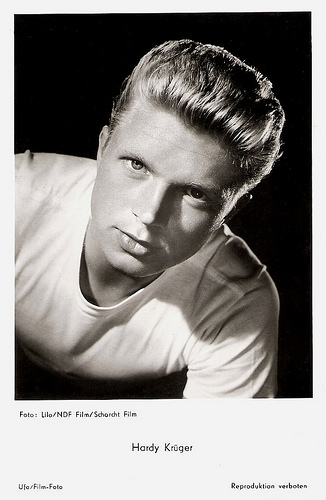
German postcard by Ufa Film-Foto, Berlin-Tempelhof, no. FK 1182. Photo: Lilo / NDF Film / Schorcht Film. Publicity still for Muss man sich gleich scheiden lassen?/Does one have to get divorced right away? (Hans Schweikart, 1953).
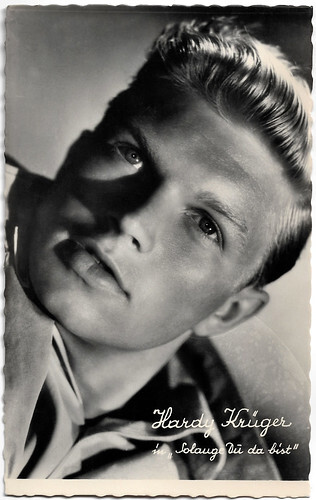
Austrian postcard by Verlag Hubmann, Wien, no. 2948. Photo: Hardy Kr��ger in Solange du da bist/As Long as You're Near Me (Harald Braun, 1953).
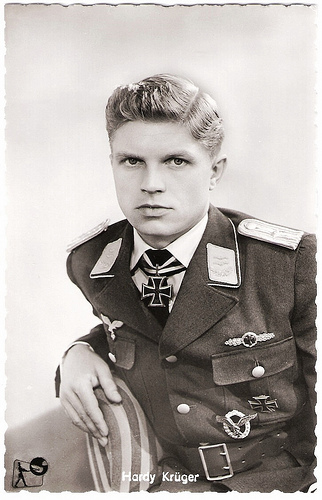
German postcard by Kolibri-Verlag G.m.b.H., Minden/Westf., no. 2727. Photo: Rank / Seeliger. Still for The One That Got Away (Roy Ward Baker, 1957).
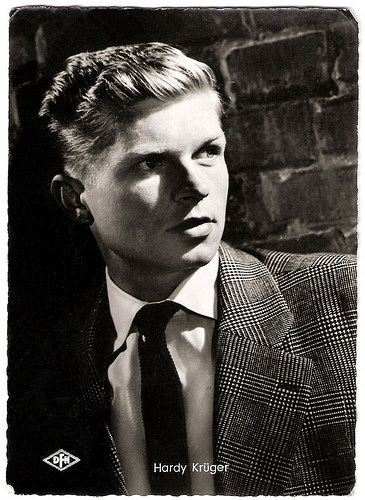
German postcard, no. 1251. Photo: Wesel / Berolina Film / Deutsche Film Hansa. Publicity still for Banktresor 713/Bank Vault 713 (Werner Klingler, 1957).
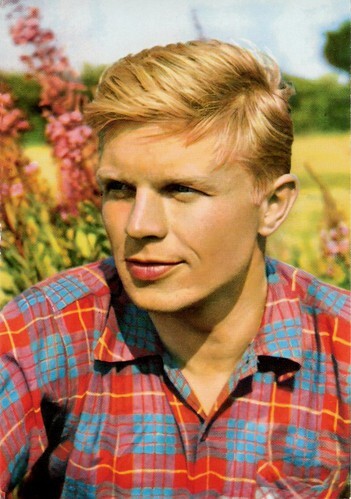
British postcard by East-West Publishers.
Young Eagle
Franz Eberhard August Kr��ger was born in 1928 in Berlin. He was the son of engineer Max Kr��ger.
From 1941 on, Hardy attended the Adolf-Hitler-Schule at Burg Sonthofen, an elite Nazi boarding school. Here the blonde and handsome 15-year-old was cast for the film Junge Adler/Young Eagles (Alfred Weidenmann, 1944) starring Willy Fritsch . This propaganda film for the Wehrmacht was filmed in the huge Ufa studio in Babelsberg.
After his successful performance as the apprentice B��umchen, director Wolfgang Liebeneiner tried to persuade him to continue his film career. In March 1945 the young Kr��ger was drafted into the SS Division 'Nibelungen', where he was drawn into heavy fighting before being captured by US forces in Tirol.
After his release, he began to write but did not publish. Instead, he started to perform in German theatres.
In 1949, he made his first post-war film, the comedy Diese Nacht vergess Ich nie/I'll Never Forget That Night (Johannes Meyer, 1949), with Gustav Fr��hlich and Winnie Markus . In the following years, his film career took off.
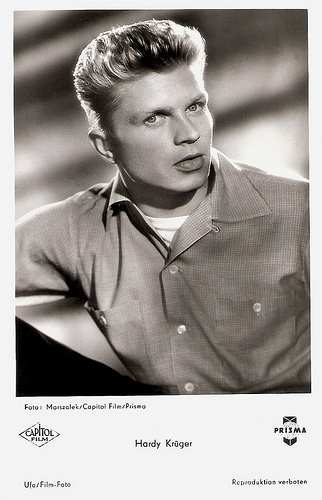
German postcard by Ufa Film-Foto, Berlin-Tempelhof, no. FK 1659. Photo: Marszalek / Capitol Film / Prisma.
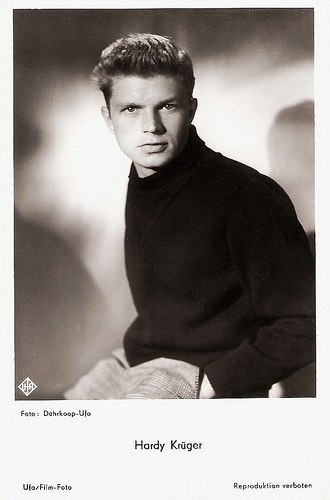
German postcard by Ufa Film-Foto, Berlin-Tempelhof, no. FK 3057. Photo: D��hrkoop / Ufa.
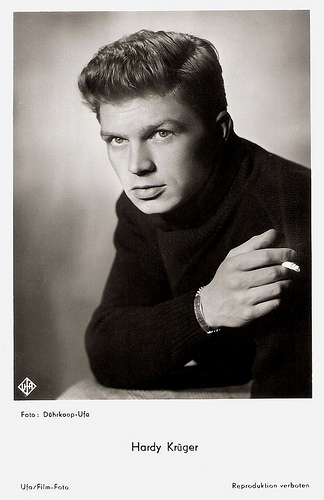
German postcard by Ufa Film-Foto, Berlin-Tempelhof, no. FK 3058. Photo: D��hrkoop / Ufa.
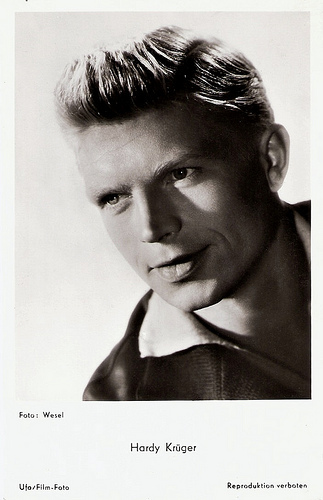
German postcard by Ufa Film-Foto, Berlin-Tempelhof, no. FK 3622. Photo: Wesel.
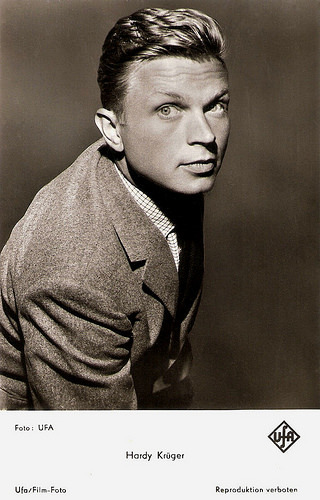
German postcard by Ufa, Berlin-Tempelhof, no. FK 4615. Photo: Ufa.
Effortlessly Natural Attitude
Hardy Kr��ger became known as a handsome young man with an effortlessly natural attitude in such films as Illusion in Moll/Illusion in a Minor Key (Rudolf Jugert, 1952) starring Hildegard Knef , the drama Solange Du da bist/As Long as You're Near Me (Harald Braun, 1953) with O.W. Fischer , and the comedy Die Jungfrau auf dem Dach/The Girl on the Roof (Otto Preminger, 1953) with Johannes Heesters .
The latter was the German version of the Hollywood production The Moon is Blue (Otto Preminger, 1953) starring William Holden and Maggie McNamara. Hardy Kr��ger and co-star Johanna Matz also appeared uncredited as tourists at the Empire State Building sequence in the American version.
The quality of some of his next films did not match his talents. And although the jungle fantasy Liane, das M��dchen aus dem Urwald/Liane, Jungle Goddess (Eduard von Borsody, 1956) with a briefly topless Marion Michael was one of the biggest German box office hits of the 1950s, he declined to star in further Liane films for 'artistic reasons'.
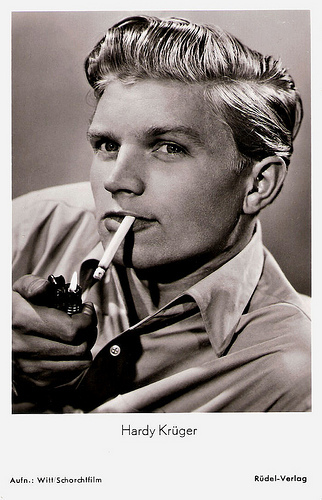
German postcard by R��del-Verlag, Hamburg-Bergedorf, no. 403. Photo: Witt / Schorchtfilm. Publicity still for Ich heisse Niki/My Name is Nicky (Rudolf Jugert, 1952).
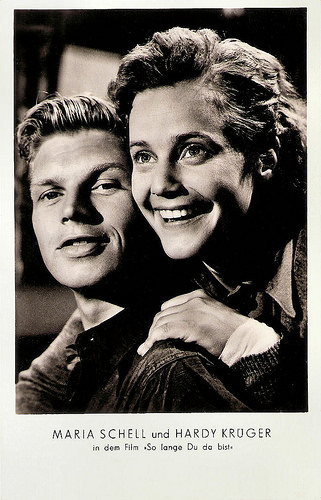
East-German postcard by Reichenbach, no. 691/56. Photo: NDF / Schorchtfilm. Publicity still for So lange Du da bist/As Long as You're Near Me (Harald Braun, 1953) with Maria Schell .
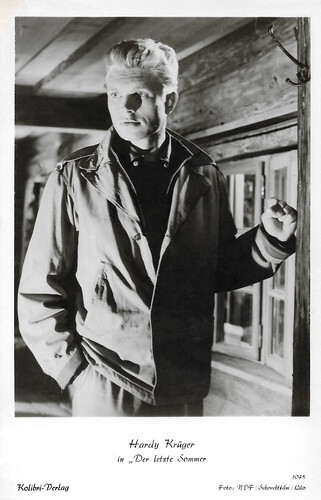
West-German postcard by Kolibri-Verlag, no. 1075. Photo: NDF / Schorchtfilm / Lilo. Hardy Kr��ger in Der letzte Sommer/The Last Summer (Harald Braun, 1954).
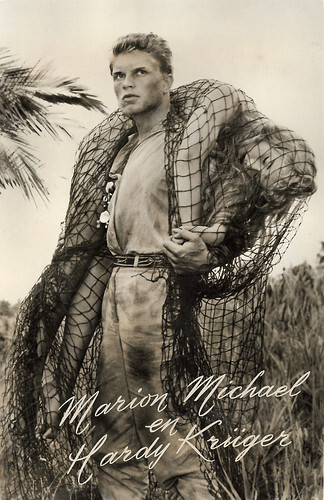
Dutch postcard by Uitgeverij Takken, Utrecht, no. 3791. Photo: NV Standaardfilms. Marion Michael and Hardy Kr��ger in Liane, das M��dchen aus dem Urwald/Liane, Jungle Goddess (Eduard von Borsody, 1956).
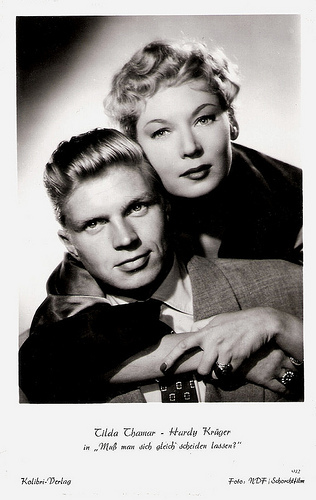
German postcard by Kolibri-Verlag, no. 912. Photo: NDF / Schorchtfilm. Publicity still for Muss man sich gleich scheiden lassen?/Does one have to get divorced right away? (Hans Schweikart, 1953) with Tilda Thamar.
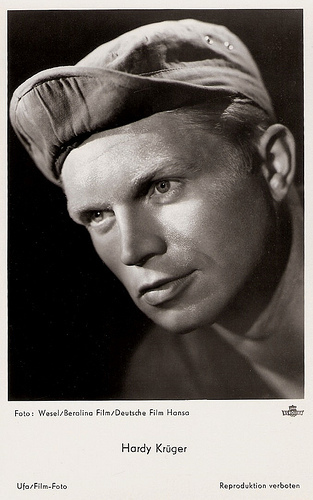
German postcard by Ufa Film-Foto, Berlin-Tempelhof, no. FK 3743. Photo: Wesel / Berolina Film / Deutsche Film Hansa. Publicity still for Banktresor 713/Bank Vault 713 (Werner Klingler, 1957)
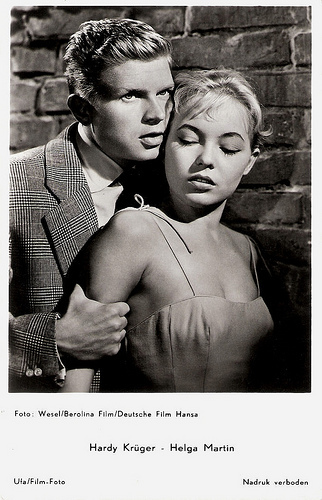
Dutch postcard by Gebr. Spanjersberg N.V., Rotterdam, no. 3747. Photo: Wesel / Berolina Film / Deutsche Film Hansa. Publicity still for Banktresor 713/Bank Vault 713 (Werner Klingler, 1957) with Helga Martin .
Soldiers and adventurers
Hardy Kr��ger was fluent in English, French, and German, and found himself in demand by British, French, American, and German producers.
J. Arthur Rank cast him in three British pictures practically filmed back-to-back. The first one was The One That Got Away (Roy Ward Baker, 1957), the story of the positive and unpolitical lieutenant Franz von Werra, the only German prisoner of war to successfully escape from numerous British POW camps during the Second World War and return to Germany.
The second was the comedy Bachelor of Hearts (Wolf Rilla, 1958), and the third was the thriller Blind Date (Joseph Losey, 1959) with Stanley Baker and Micheline Presle . In reviews Hardy, was described as 'ruggedly handsome' and a 'blond heartthrob'.
Despite anti-German sentiment still prevailing in postwar Europe, he became an international favourite. He appeared in the German Shakespeare update Der Rest ist Schweigen/The Rest Is Silence (Helmut K��utner, 1959), and in the French WW II adventure Un taxi pour Tobrouk/Taxi for Tobruk (Denys de La Patelli��re, 1960).
A highlight was the French drama Les dimanches de Ville d'Avray/Sundays and Cybele (Serge Bourguignon, 1962). This hauntingly beautiful film about a platonic relationship between a former bomber pilot with war trauma and amnesia, and a 12-year-old orphan girl (Patricia Gozzi), was awarded the 1962 Best Foreign Film Academy Award. It paved Kr��ger's way to Hollywood.
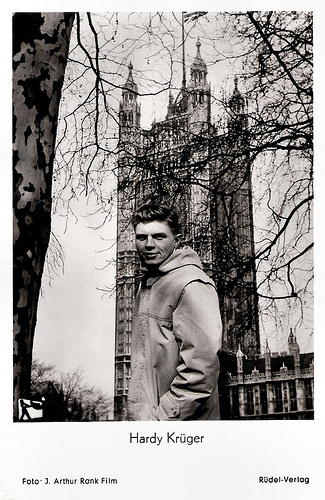
German postcard by R��del-Verlag, no. 2134. Photo: J. Arthur Rank Film. Publicity still for The One That Got Away (Roy Ward Baker, 1957).
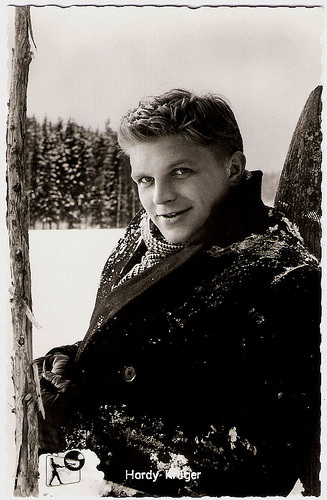
German postcard by Kolibri-Verlag, no. 2799. Photo: J. Arthur Rank Film. Publicity still for The One That Got Away (Roy Ward Baker, 1957).
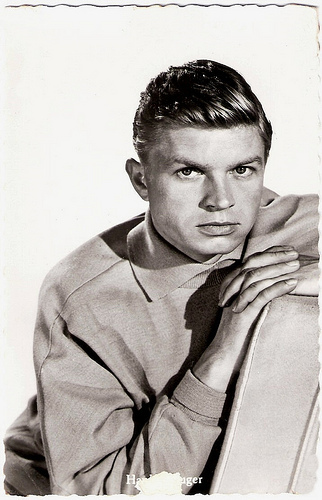
Dutch postcard by NV v.h. Weenenk & Snel, Baarn, no. 759. Photo: Rank Film for The One That Got Away (1957).

German postcard by Kolibri-Verlag G.m.b.H., Minden/Westf., no. 783. Photo: Rank. Still for Bachelor of Hearts (Wolf Rilla, 1958).
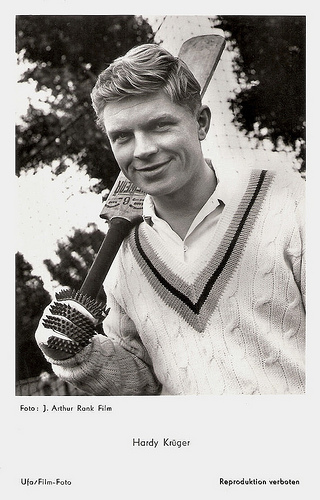
German postcard by Ufa, Berlin-Tempelhof, no. FK 4334. Photo: J. Arthur Rank Film. Publicity still for Bachelor of Hearts (Wolf Rilla, 1958).
Hollywood
In the USA, Hardy Kr��ger started in the African adventure Hatari! (Howard Hawks, 1962), at the side of John Wayne and Elsa Martinelli .
His later films included Hollywood productions like the original version of The Flight of the Phoenix (Robert Aldrich, 1965) about the survivors of a plane crash in the middle of the Sahara desert, and the war comedy-drama The Secret of Santa Vittoria (Stanley Kramer, 1969) with Anthony Quinn and Anna Magnani .
In the star-studded war epic A Bridge Too Far (Richard Attenborough, 1977), he portrayed a Nazi General. Hardy Kr��ger related during the shooting how he hated to wear a Nazi uniform. Between takes, he wore a topcoat over his SS uniform so as "not to remind myself of my childhood in Germany during WW II." Although he often played German soldiers, his characters were mostly positive, he personified the 'good German'.
Kr��ger also appeared in many European productions like Le Chant du monde/Song of the World (Marcel Camus, 1965) with Catherine Deneuve , the controversial box office hit La Monaca di Monza/The Nun of Monza (Eriprando Visconti, 1969) about a 17th-century Italian nun's long-repressed sexual passion, the Italian-Russian coproduction Krasnaya palatka/The Red Tent (Mikhail Kalatozov, 1969) starring Sean Connery , and the murder mystery �� chacun son enfer/To Each His Hell (Andr�� Cayatte, 1977) with Annie Girardot .
During that period, he made his sole appearance in a film of the New German Cinema in Peter Schamoni's comedy-western Potato Fritz/Montana Trap (Peter Schamoni, 1976).
Most memorable is his role as the Prussian Captain Potzdorf in the Oscar winner Barry Lyndon (Stanley Kubrick, 1975) featuring Ryan O'Neal. His last film appearance was in the Swedish-British thriller Slagsk��mpen/The Inside Man (Tom Clegg, 1984) starring Dennis Hopper .
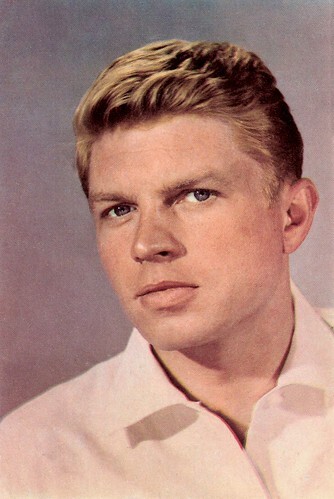
Belgian card by Cox, no. 35.
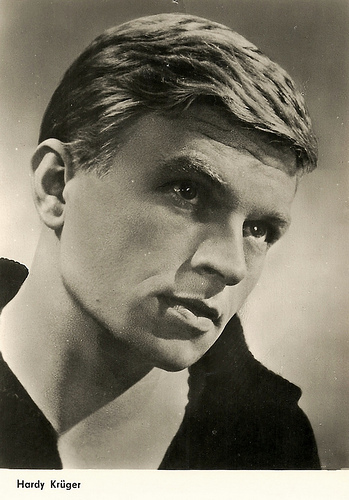
East-German postcard by VEB Progress Filmvertrieb. Starfoto, no. 1467. Photo: Hardy Kr��ger in the German-British film Alles spricht gegen van Rooyen/Blind Date (Joseph Losey, 1959).
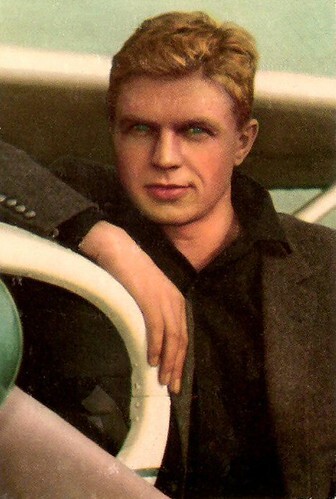
Belgian collector's card, no. 93.
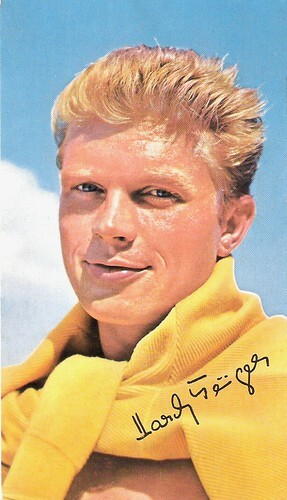
German collector's card by Luxor.
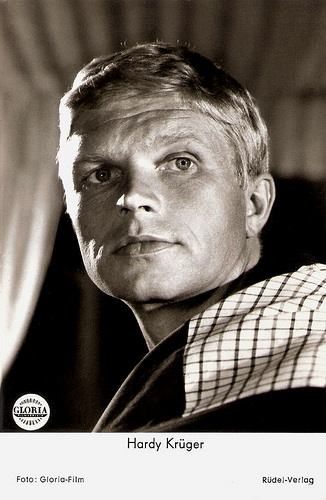
German postcard by R��del-Verlag, Hamburg, no. 4552. Photo: Gloria Film. Publicity still for Los pianos mec��nicos/The Uninhibited (Juan Antonio Bardem, 1965).
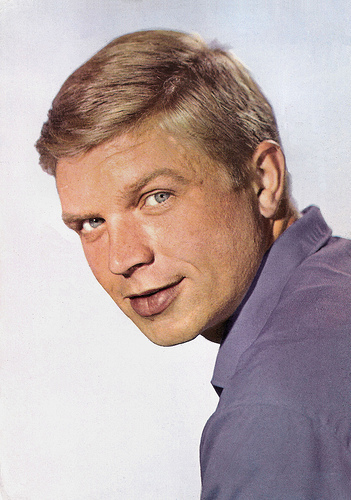
Spanish postcard by Postal Oscarcolor, no. 156.
A globe-trotter for TV
In the 1970s he had taken up writing fiction and non-fiction, and he started a new career as a globe trotter for TV. In 1983, after several novels, story collections, and a children's book he published the novel 'Junge Unrast', an only slightly disguised autobiographic account of his life.
On television, he played the role of Field Marshal Erwin Rommel in the popular American TV series War and Remembrance (Dan Curtis, 1989) starring Robert Mitchum . In 2011 appeared as the pater familias in the TV film Die Familie/The Family (Carlo Rola, 2011) with Gila von Weitershausen as his wife.
Hardy Kr��ger married three times. His marriages with actress Renate Densow and Italian painter Francesca Marazzi ended in a divorce. He married his third wife, the American Anita Park, in 1978. He had three children. His daughter by Renate Densow, Christiane Kr��ger (born in 1945, when he was only 17), and his son by Francesca Marazzi, Hardy Kr��ger Jr. are both actors too.
Hardy Kr��ger was awarded many times for his work. In 2001 he was made Officier de la L��gion d���Honneur in France, and in 2009, Germany honoured him with the Gro��es Verdienstkreuz (Great Cross of Merit). Hardy and Anita Kr��ger lived in California and in Hamburg. Hardy Kr��ger died at his home in Palm Springs, California, on 19 January 2022, at the age of 93.
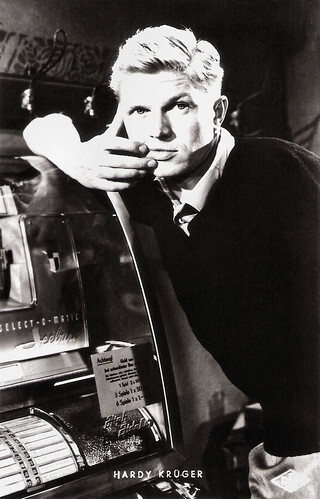
West-German postcard by Netter's Star Verlag, Berlin, no. 1256.
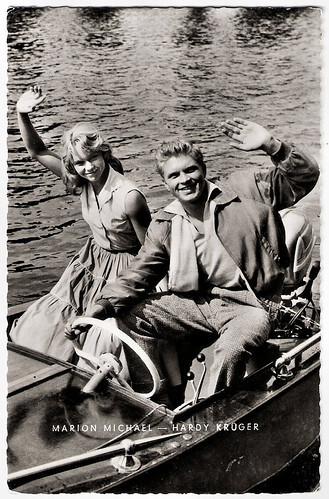
West-German postcard by Kunst und Bild, Berlin-Charlottenburg, no. V 139. Marion Michael and Hardy Kr��ger.
Trailer for The One That Got Away (1957). Source: VCIClassicMovies (YouTube).
Hardy Kr��ger sings I'm A Lonely Man. From the film Blind Date (1959). Source: Rudi Polt (YouTube).
Trailer for Hatari (1962). Source: Paramount Movies Digital (YouTube).
Trailer for Barry Lyndon (1975). Source: Warner Bros (YouTube).
Sources: Hal Erickson (AllMovie), Stephanie D'heil (Steffi-line - German), (IMDb), Filmportal.de, Wikipedia, and .

German postcard by Ufa Film-Foto, Berlin-Tempelhof, no. FK 1182. Photo: Lilo / NDF Film / Schorcht Film. Publicity still for Muss man sich gleich scheiden lassen?/Does one have to get divorced right away? (Hans Schweikart, 1953).

Austrian postcard by Verlag Hubmann, Wien, no. 2948. Photo: Hardy Kr��ger in Solange du da bist/As Long as You're Near Me (Harald Braun, 1953).

German postcard by Kolibri-Verlag G.m.b.H., Minden/Westf., no. 2727. Photo: Rank / Seeliger. Still for The One That Got Away (Roy Ward Baker, 1957).

German postcard, no. 1251. Photo: Wesel / Berolina Film / Deutsche Film Hansa. Publicity still for Banktresor 713/Bank Vault 713 (Werner Klingler, 1957).

British postcard by East-West Publishers.
Young Eagle
Franz Eberhard August Kr��ger was born in 1928 in Berlin. He was the son of engineer Max Kr��ger.
From 1941 on, Hardy attended the Adolf-Hitler-Schule at Burg Sonthofen, an elite Nazi boarding school. Here the blonde and handsome 15-year-old was cast for the film Junge Adler/Young Eagles (Alfred Weidenmann, 1944) starring Willy Fritsch . This propaganda film for the Wehrmacht was filmed in the huge Ufa studio in Babelsberg.
After his successful performance as the apprentice B��umchen, director Wolfgang Liebeneiner tried to persuade him to continue his film career. In March 1945 the young Kr��ger was drafted into the SS Division 'Nibelungen', where he was drawn into heavy fighting before being captured by US forces in Tirol.
After his release, he began to write but did not publish. Instead, he started to perform in German theatres.
In 1949, he made his first post-war film, the comedy Diese Nacht vergess Ich nie/I'll Never Forget That Night (Johannes Meyer, 1949), with Gustav Fr��hlich and Winnie Markus . In the following years, his film career took off.

German postcard by Ufa Film-Foto, Berlin-Tempelhof, no. FK 1659. Photo: Marszalek / Capitol Film / Prisma.

German postcard by Ufa Film-Foto, Berlin-Tempelhof, no. FK 3057. Photo: D��hrkoop / Ufa.

German postcard by Ufa Film-Foto, Berlin-Tempelhof, no. FK 3058. Photo: D��hrkoop / Ufa.

German postcard by Ufa Film-Foto, Berlin-Tempelhof, no. FK 3622. Photo: Wesel.

German postcard by Ufa, Berlin-Tempelhof, no. FK 4615. Photo: Ufa.
Effortlessly Natural Attitude
Hardy Kr��ger became known as a handsome young man with an effortlessly natural attitude in such films as Illusion in Moll/Illusion in a Minor Key (Rudolf Jugert, 1952) starring Hildegard Knef , the drama Solange Du da bist/As Long as You're Near Me (Harald Braun, 1953) with O.W. Fischer , and the comedy Die Jungfrau auf dem Dach/The Girl on the Roof (Otto Preminger, 1953) with Johannes Heesters .
The latter was the German version of the Hollywood production The Moon is Blue (Otto Preminger, 1953) starring William Holden and Maggie McNamara. Hardy Kr��ger and co-star Johanna Matz also appeared uncredited as tourists at the Empire State Building sequence in the American version.
The quality of some of his next films did not match his talents. And although the jungle fantasy Liane, das M��dchen aus dem Urwald/Liane, Jungle Goddess (Eduard von Borsody, 1956) with a briefly topless Marion Michael was one of the biggest German box office hits of the 1950s, he declined to star in further Liane films for 'artistic reasons'.

German postcard by R��del-Verlag, Hamburg-Bergedorf, no. 403. Photo: Witt / Schorchtfilm. Publicity still for Ich heisse Niki/My Name is Nicky (Rudolf Jugert, 1952).

East-German postcard by Reichenbach, no. 691/56. Photo: NDF / Schorchtfilm. Publicity still for So lange Du da bist/As Long as You're Near Me (Harald Braun, 1953) with Maria Schell .

West-German postcard by Kolibri-Verlag, no. 1075. Photo: NDF / Schorchtfilm / Lilo. Hardy Kr��ger in Der letzte Sommer/The Last Summer (Harald Braun, 1954).

Dutch postcard by Uitgeverij Takken, Utrecht, no. 3791. Photo: NV Standaardfilms. Marion Michael and Hardy Kr��ger in Liane, das M��dchen aus dem Urwald/Liane, Jungle Goddess (Eduard von Borsody, 1956).

German postcard by Kolibri-Verlag, no. 912. Photo: NDF / Schorchtfilm. Publicity still for Muss man sich gleich scheiden lassen?/Does one have to get divorced right away? (Hans Schweikart, 1953) with Tilda Thamar.

German postcard by Ufa Film-Foto, Berlin-Tempelhof, no. FK 3743. Photo: Wesel / Berolina Film / Deutsche Film Hansa. Publicity still for Banktresor 713/Bank Vault 713 (Werner Klingler, 1957)

Dutch postcard by Gebr. Spanjersberg N.V., Rotterdam, no. 3747. Photo: Wesel / Berolina Film / Deutsche Film Hansa. Publicity still for Banktresor 713/Bank Vault 713 (Werner Klingler, 1957) with Helga Martin .
Soldiers and adventurers
Hardy Kr��ger was fluent in English, French, and German, and found himself in demand by British, French, American, and German producers.
J. Arthur Rank cast him in three British pictures practically filmed back-to-back. The first one was The One That Got Away (Roy Ward Baker, 1957), the story of the positive and unpolitical lieutenant Franz von Werra, the only German prisoner of war to successfully escape from numerous British POW camps during the Second World War and return to Germany.
The second was the comedy Bachelor of Hearts (Wolf Rilla, 1958), and the third was the thriller Blind Date (Joseph Losey, 1959) with Stanley Baker and Micheline Presle . In reviews Hardy, was described as 'ruggedly handsome' and a 'blond heartthrob'.
Despite anti-German sentiment still prevailing in postwar Europe, he became an international favourite. He appeared in the German Shakespeare update Der Rest ist Schweigen/The Rest Is Silence (Helmut K��utner, 1959), and in the French WW II adventure Un taxi pour Tobrouk/Taxi for Tobruk (Denys de La Patelli��re, 1960).
A highlight was the French drama Les dimanches de Ville d'Avray/Sundays and Cybele (Serge Bourguignon, 1962). This hauntingly beautiful film about a platonic relationship between a former bomber pilot with war trauma and amnesia, and a 12-year-old orphan girl (Patricia Gozzi), was awarded the 1962 Best Foreign Film Academy Award. It paved Kr��ger's way to Hollywood.

German postcard by R��del-Verlag, no. 2134. Photo: J. Arthur Rank Film. Publicity still for The One That Got Away (Roy Ward Baker, 1957).

German postcard by Kolibri-Verlag, no. 2799. Photo: J. Arthur Rank Film. Publicity still for The One That Got Away (Roy Ward Baker, 1957).

Dutch postcard by NV v.h. Weenenk & Snel, Baarn, no. 759. Photo: Rank Film for The One That Got Away (1957).

German postcard by Kolibri-Verlag G.m.b.H., Minden/Westf., no. 783. Photo: Rank. Still for Bachelor of Hearts (Wolf Rilla, 1958).

German postcard by Ufa, Berlin-Tempelhof, no. FK 4334. Photo: J. Arthur Rank Film. Publicity still for Bachelor of Hearts (Wolf Rilla, 1958).
Hollywood
In the USA, Hardy Kr��ger started in the African adventure Hatari! (Howard Hawks, 1962), at the side of John Wayne and Elsa Martinelli .
His later films included Hollywood productions like the original version of The Flight of the Phoenix (Robert Aldrich, 1965) about the survivors of a plane crash in the middle of the Sahara desert, and the war comedy-drama The Secret of Santa Vittoria (Stanley Kramer, 1969) with Anthony Quinn and Anna Magnani .
In the star-studded war epic A Bridge Too Far (Richard Attenborough, 1977), he portrayed a Nazi General. Hardy Kr��ger related during the shooting how he hated to wear a Nazi uniform. Between takes, he wore a topcoat over his SS uniform so as "not to remind myself of my childhood in Germany during WW II." Although he often played German soldiers, his characters were mostly positive, he personified the 'good German'.
Kr��ger also appeared in many European productions like Le Chant du monde/Song of the World (Marcel Camus, 1965) with Catherine Deneuve , the controversial box office hit La Monaca di Monza/The Nun of Monza (Eriprando Visconti, 1969) about a 17th-century Italian nun's long-repressed sexual passion, the Italian-Russian coproduction Krasnaya palatka/The Red Tent (Mikhail Kalatozov, 1969) starring Sean Connery , and the murder mystery �� chacun son enfer/To Each His Hell (Andr�� Cayatte, 1977) with Annie Girardot .
During that period, he made his sole appearance in a film of the New German Cinema in Peter Schamoni's comedy-western Potato Fritz/Montana Trap (Peter Schamoni, 1976).
Most memorable is his role as the Prussian Captain Potzdorf in the Oscar winner Barry Lyndon (Stanley Kubrick, 1975) featuring Ryan O'Neal. His last film appearance was in the Swedish-British thriller Slagsk��mpen/The Inside Man (Tom Clegg, 1984) starring Dennis Hopper .

Belgian card by Cox, no. 35.

East-German postcard by VEB Progress Filmvertrieb. Starfoto, no. 1467. Photo: Hardy Kr��ger in the German-British film Alles spricht gegen van Rooyen/Blind Date (Joseph Losey, 1959).

Belgian collector's card, no. 93.

German collector's card by Luxor.

German postcard by R��del-Verlag, Hamburg, no. 4552. Photo: Gloria Film. Publicity still for Los pianos mec��nicos/The Uninhibited (Juan Antonio Bardem, 1965).

Spanish postcard by Postal Oscarcolor, no. 156.
A globe-trotter for TV
In the 1970s he had taken up writing fiction and non-fiction, and he started a new career as a globe trotter for TV. In 1983, after several novels, story collections, and a children's book he published the novel 'Junge Unrast', an only slightly disguised autobiographic account of his life.
On television, he played the role of Field Marshal Erwin Rommel in the popular American TV series War and Remembrance (Dan Curtis, 1989) starring Robert Mitchum . In 2011 appeared as the pater familias in the TV film Die Familie/The Family (Carlo Rola, 2011) with Gila von Weitershausen as his wife.
Hardy Kr��ger married three times. His marriages with actress Renate Densow and Italian painter Francesca Marazzi ended in a divorce. He married his third wife, the American Anita Park, in 1978. He had three children. His daughter by Renate Densow, Christiane Kr��ger (born in 1945, when he was only 17), and his son by Francesca Marazzi, Hardy Kr��ger Jr. are both actors too.
Hardy Kr��ger was awarded many times for his work. In 2001 he was made Officier de la L��gion d���Honneur in France, and in 2009, Germany honoured him with the Gro��es Verdienstkreuz (Great Cross of Merit). Hardy and Anita Kr��ger lived in California and in Hamburg. Hardy Kr��ger died at his home in Palm Springs, California, on 19 January 2022, at the age of 93.

West-German postcard by Netter's Star Verlag, Berlin, no. 1256.

West-German postcard by Kunst und Bild, Berlin-Charlottenburg, no. V 139. Marion Michael and Hardy Kr��ger.
Trailer for The One That Got Away (1957). Source: VCIClassicMovies (YouTube).
Hardy Kr��ger sings I'm A Lonely Man. From the film Blind Date (1959). Source: Rudi Polt (YouTube).
Trailer for Hatari (1962). Source: Paramount Movies Digital (YouTube).
Trailer for Barry Lyndon (1975). Source: Warner Bros (YouTube).
Sources: Hal Erickson (AllMovie), Stephanie D'heil (Steffi-line - German), (IMDb), Filmportal.de, Wikipedia, and .
Published on January 19, 2022 22:01
Hardy Krüger (1928-2022)
German actor and writer Hardy Krüger (1928) passed away on 19 January 2022. The blond heartthrob acted in numerous European films of the 1950s and 1960s and also in several classic American films. He played friendly soldiers and adventurers in numerous German, British and French films and also in some Hollywood classics. Although he often was typecasted as the Aryan Nazi, he hated wearing the brown uniform. Krüger was 93.

German postcard by Ufa Film-Foto, Berlin-Tempelhof, no. FK 1182. Photo: Lilo / NDF Film / Schorcht Film. Publicity still for Muss man sich gleich scheiden lassen?/Does one have to get divorced right away? (Hans Schweikart, 1953).

Austrian postcard by Verlag Hubmann, Wien, no. 2948. Photo: Hardy Krüger in Solange du da bist/As Long as You're Near Me (Harald Braun, 1953).

German postcard by Kolibri-Verlag G.m.b.H., Minden/Westf., no. 2727. Photo: Rank / Seeliger. Still for The One That Got Away (Roy Ward Baker, 1957).

German postcard, no. 1251. Photo: Wesel / Berolina Film / Deutsche Film Hansa. Publicity still for Banktresor 713/Bank Vault 713 (Werner Klingler, 1957).

British postcard by East-West Publishers.
Young Eagle
Franz Eberhard August Krüger was born in 1928 in Berlin. He was the son of engineer Max Krüger.
From 1941 on, Hardy attended the Adolf-Hitler-Schule at Burg Sonthofen, an elite Nazi boarding school. Here the blonde and handsome 15-year-old was cast for the film Junge Adler/Young Eagles (Alfred Weidenmann, 1944) starring Willy Fritsch . This propaganda film for the Wehrmacht was filmed in the huge Ufa studio in Babelsberg.
After his successful performance as the apprentice Bäumchen, director Wolfgang Liebeneiner tried to persuade him to continue his film career. In March 1945 the young Krüger was drafted into the SS Division 'Nibelungen', where he was drawn into heavy fighting before being captured by US forces in Tirol.
After his release, he began to write but did not publish. Instead, he started to perform in German theatres.
In 1949, he made his first post-war film, the comedy Diese Nacht vergess Ich nie/I'll Never Forget That Night (Johannes Meyer, 1949), with Gustav Fröhlich and Winnie Markus . In the following years, his film career took off.

German postcard by Ufa Film-Foto, Berlin-Tempelhof, no. FK 1659. Photo: Marszalek / Capitol Film / Prisma.

German postcard by Ufa Film-Foto, Berlin-Tempelhof, no. FK 3057. Photo: Dührkoop / Ufa.

German postcard by Ufa Film-Foto, Berlin-Tempelhof, no. FK 3058. Photo: Dührkoop / Ufa.

German postcard by Ufa Film-Foto, Berlin-Tempelhof, no. FK 3622. Photo: Wesel.

German postcard by Ufa, Berlin-Tempelhof, no. FK 4615. Photo: Ufa.
Effortlessly Natural Attitude
Hardy Krüger became known as a handsome young man with an effortlessly natural attitude in such films as Illusion in Moll/Illusion in a Minor Key (Rudolf Jugert, 1952) starring Hildegard Knef , the drama Solange Du da bist/As Long as You're Near Me (Harald Braun, 1953) with O.W. Fischer , and the comedy Die Jungfrau auf dem Dach/The Girl on the Roof (Otto Preminger, 1953) with Johannes Heesters .
The latter was the German version of the Hollywood production The Moon is Blue (Otto Preminger, 1953) starring William Holden and Maggie McNamara. Hardy Krüger and co-star Johanna Matz also appeared uncredited as tourists at the Empire State Building sequence in the American version.
The quality of some of his next films did not match his talents. And although the jungle fantasy Liane, das Mädchen aus dem Urwald/Liane, Jungle Goddess (Eduard von Borsody, 1956) with a briefly topless Marion Michael was one of the biggest German box office hits of the 1950s, he declined to star in further Liane films for 'artistic reasons'.

German postcard by Rüdel-Verlag, Hamburg-Bergedorf, no. 403. Photo: Witt / Schorchtfilm. Publicity still for Ich heisse Niki/My Name is Nicky (Rudolf Jugert, 1952).

East-German postcard by Reichenbach, no. 691/56. Photo: NDF / Schorchtfilm. Publicity still for So lange Du da bist/As Long as You're Near Me (Harald Braun, 1953) with Maria Schell .

West-German postcard by Kolibri-Verlag, no. 1075. Photo: NDF / Schorchtfilm / Lilo. Hardy Krüger in Der letzte Sommer/The Last Summer (Harald Braun, 1954).

Dutch postcard by Uitgeverij Takken, Utrecht, no. 3791. Photo: NV Standaardfilms. Marion Michael and Hardy Krüger in Liane, das Mädchen aus dem Urwald/Liane, Jungle Goddess (Eduard von Borsody, 1956).

German postcard by Kolibri-Verlag, no. 912. Photo: NDF / Schorchtfilm. Publicity still for Muss man sich gleich scheiden lassen?/Does one have to get divorced right away? (Hans Schweikart, 1953) with Tilda Thamar.

German postcard by Ufa Film-Foto, Berlin-Tempelhof, no. FK 3743. Photo: Wesel / Berolina Film / Deutsche Film Hansa. Publicity still for Banktresor 713/Bank Vault 713 (Werner Klingler, 1957)

Dutch postcard by Gebr. Spanjersberg N.V., Rotterdam, no. 3747. Photo: Wesel / Berolina Film / Deutsche Film Hansa. Publicity still for Banktresor 713/Bank Vault 713 (Werner Klingler, 1957) with Helga Martin .
Soldiers and adventurers
Hardy Krüger is fluent in English, French, and German, and found himself in demand by British, French, American, and German producers.
J. Arthur Rank cast him in three British pictures practically filmed back-to-back. The first one was The One That Got Away (Roy Ward Baker, 1957), the story of the positive and unpolitical lieutenant Franz von Werra, the only German prisoner of war to successfully escape from numerous British POW camps during the Second World War and return to Germany.
The second was the comedy Bachelor of Hearts (Wolf Rilla, 1958), and the third was the thriller Blind Date (Joseph Losey, 1959) with Stanley Baker and Micheline Presle . In reviews Hardy, was described as 'ruggedly handsome' and a 'blond heartthrob'.
Despite anti-German sentiment still prevailing in postwar Europe, he became an international favourite. He appeared in the German Shakespeare update Der Rest ist Schweigen/The Rest Is Silence (Helmut Käutner, 1959), and in the French WW II adventure Un taxi pour Tobrouk/Taxi for Tobruk (Denys de La Patellière, 1960).
A highlight was the French drama Les dimanches de Ville d'Avray/Sundays and Cybele (Serge Bourguignon, 1962). This hauntingly beautiful film about a platonic relationship between a former bomber pilot with war trauma and amnesia, and a 12-year-old orphan girl (Patricia Gozzi), was awarded the 1962 Best Foreign Film Academy Award. It paved Krüger's way to Hollywood.

German postcard by Rüdel-Verlag, no. 2134. Photo: J. Arthur Rank Film. Publicity still for The One That Got Away (Roy Ward Baker, 1957).

German postcard by Kolibri-Verlag, no. 2799. Photo: J. Arthur Rank Film. Publicity still for The One That Got Away (Roy Ward Baker, 1957).

Dutch postcard by NV v.h. Weenenk & Snel, Baarn, no. 759. Photo: Rank Film for The One That Got Away (1957).

German postcard by Kolibri-Verlag G.m.b.H., Minden/Westf., no. 783. Photo: Rank. Still for Bachelor of Hearts (Wolf Rilla, 1958).

German postcard by Ufa, Berlin-Tempelhof, no. FK 4334. Photo: J. Arthur Rank Film. Publicity still for Bachelor of Hearts (Wolf Rilla, 1958).
Hollywood
In the USA, Hardy Krüger started in the African adventure Hatari! (Howard Hawks, 1962), at the side of John Wayne and Elsa Martinelli .
His later films included Hollywood productions like the original version of The Flight of the Phoenix (Robert Aldrich, 1965) about the survivors of a plane crash in the middle of the Sahara desert, and the war comedy-drama The Secret of Santa Vittoria (Stanley Kramer, 1969) with Anthony Quinn and Anna Magnani .
In the star-studded war epic A Bridge Too Far (Richard Attenborough, 1977), he portrayed a Nazi General. Hardy Krüger related during the shooting how he hated to wear a Nazi uniform. Between takes, he wore a topcoat over his SS uniform so as "not to remind myself of my childhood in Germany during WW II." Although he often played German soldiers, his characters were mostly positive, he personified the 'good German'.
Krüger also appeared in many European productions like Le Chant du monde/Song of the World (Marcel Camus, 1965) with Catherine Deneuve , the controversial box office hit La Monaca di Monza/The Nun of Monza (Eriprando Visconti, 1969) about a 17th-century Italian nun's long-repressed sexual passion, the Italian-Russian coproduction Krasnaya palatka/The Red Tent (Mikhail Kalatozov, 1969) starring Sean Connery , and the murder mystery À chacun son enfer/To Each His Hell (André Cayatte, 1977) with Annie Girardot .
During that period, he made his sole appearance in a film of the New German Cinema in Peter Schamoni's comedy-western Potato Fritz/Montana Trap (Peter Schamoni, 1976).
Most memorable is his role as the Prussian Captain Potzdorf in the Oscar winner Barry Lyndon (Stanley Kubrick, 1975) featuring Ryan O'Neal. His last film appearance was in the Swedish-British thriller Slagskämpen/The Inside Man (Tom Clegg, 1984) starring Dennis Hopper .

Belgian card by Cox, no. 35.

East-German postcard by VEB Progress Filmvertrieb. Starfoto, no. 1467. Photo: Hardy Krüger in the German-British film Alles spricht gegen van Rooyen/Blind Date (Joseph Losey, 1959).

Belgian collector's card, no. 93.

German collector's card by Luxor.

German postcard by Rüdel-Verlag, Hamburg, no. 4552. Photo: Gloria Film. Publicity still for Los pianos mecánicos/The Uninhibited (Juan Antonio Bardem, 1965).

Spanish postcard by Postal Oscarcolor, no. 156.
A globe-trotter for TV
In the 1970s he had taken up writing fiction and non-fiction, and he started a new career as a globe trotter for TV. In 1983, after several novels, story collections, and a children's book he published the novel 'Junge Unrast', an only slightly disguised autobiographic account of his life.
On television, he played the role of Field Marshal Erwin Rommel in the popular American TV series War and Remembrance (Dan Curtis, 1989) starring Robert Mitchum . In 2011 appeared as the pater familias in the TV film Die Familie/The Family (Carlo Rola, 2011) with Gila von Weitershausen as his wife.
Hardy Krüger married three times. His marriages with actress Renate Densow and Italian painter Francesca Marazzi ended in a divorce. He married his third wife, the American Anita Park, in 1978. He had three children. His daughter by Renate Densow, Christiane Krüger (born in 1945, when he was only 17), and his son by Francesca Marazzi, Hardy Krüger Jr. are both actors too.
Hardy Krüger was awarded many times for his work. In 2001 he was made Officier de la Légion d’Honneur in France, and in 2009, Germany honoured him with the Großes Verdienstkreuz (Great Cross of Merit). Hardy and Anita Krüger lived in California and in Hamburg. Hardy Krüger died at his home in Palm Springs, California, on 19 January 2022, at the age of 93.

West-German postcard by Netter's Star Verlag, Berlin, no. 1256.

West-German postcard by Kunst und Bild, Berlin-Charlottenburg, no. V 139. Marion Michael and Hardy Krüger.
Trailer for The One That Got Away (1957). Source: VCIClassicMovies (YouTube).
Hardy Krüger sings I'm A Lonely Man. From the film Blind Date (1959). Source: Rudi Polt (YouTube).
Trailer for Hatari (1962). Source: Paramount Movies Digital (YouTube).
Trailer for Barry Lyndon (1975). Source: Warner Bros (YouTube).
Sources: Hal Erickson (AllMovie), Stephanie D'heil (Steffi-line - German), (IMDb), Filmportal.de, Wikipedia, and .

German postcard by Ufa Film-Foto, Berlin-Tempelhof, no. FK 1182. Photo: Lilo / NDF Film / Schorcht Film. Publicity still for Muss man sich gleich scheiden lassen?/Does one have to get divorced right away? (Hans Schweikart, 1953).

Austrian postcard by Verlag Hubmann, Wien, no. 2948. Photo: Hardy Krüger in Solange du da bist/As Long as You're Near Me (Harald Braun, 1953).

German postcard by Kolibri-Verlag G.m.b.H., Minden/Westf., no. 2727. Photo: Rank / Seeliger. Still for The One That Got Away (Roy Ward Baker, 1957).

German postcard, no. 1251. Photo: Wesel / Berolina Film / Deutsche Film Hansa. Publicity still for Banktresor 713/Bank Vault 713 (Werner Klingler, 1957).

British postcard by East-West Publishers.
Young Eagle
Franz Eberhard August Krüger was born in 1928 in Berlin. He was the son of engineer Max Krüger.
From 1941 on, Hardy attended the Adolf-Hitler-Schule at Burg Sonthofen, an elite Nazi boarding school. Here the blonde and handsome 15-year-old was cast for the film Junge Adler/Young Eagles (Alfred Weidenmann, 1944) starring Willy Fritsch . This propaganda film for the Wehrmacht was filmed in the huge Ufa studio in Babelsberg.
After his successful performance as the apprentice Bäumchen, director Wolfgang Liebeneiner tried to persuade him to continue his film career. In March 1945 the young Krüger was drafted into the SS Division 'Nibelungen', where he was drawn into heavy fighting before being captured by US forces in Tirol.
After his release, he began to write but did not publish. Instead, he started to perform in German theatres.
In 1949, he made his first post-war film, the comedy Diese Nacht vergess Ich nie/I'll Never Forget That Night (Johannes Meyer, 1949), with Gustav Fröhlich and Winnie Markus . In the following years, his film career took off.

German postcard by Ufa Film-Foto, Berlin-Tempelhof, no. FK 1659. Photo: Marszalek / Capitol Film / Prisma.

German postcard by Ufa Film-Foto, Berlin-Tempelhof, no. FK 3057. Photo: Dührkoop / Ufa.

German postcard by Ufa Film-Foto, Berlin-Tempelhof, no. FK 3058. Photo: Dührkoop / Ufa.

German postcard by Ufa Film-Foto, Berlin-Tempelhof, no. FK 3622. Photo: Wesel.

German postcard by Ufa, Berlin-Tempelhof, no. FK 4615. Photo: Ufa.
Effortlessly Natural Attitude
Hardy Krüger became known as a handsome young man with an effortlessly natural attitude in such films as Illusion in Moll/Illusion in a Minor Key (Rudolf Jugert, 1952) starring Hildegard Knef , the drama Solange Du da bist/As Long as You're Near Me (Harald Braun, 1953) with O.W. Fischer , and the comedy Die Jungfrau auf dem Dach/The Girl on the Roof (Otto Preminger, 1953) with Johannes Heesters .
The latter was the German version of the Hollywood production The Moon is Blue (Otto Preminger, 1953) starring William Holden and Maggie McNamara. Hardy Krüger and co-star Johanna Matz also appeared uncredited as tourists at the Empire State Building sequence in the American version.
The quality of some of his next films did not match his talents. And although the jungle fantasy Liane, das Mädchen aus dem Urwald/Liane, Jungle Goddess (Eduard von Borsody, 1956) with a briefly topless Marion Michael was one of the biggest German box office hits of the 1950s, he declined to star in further Liane films for 'artistic reasons'.

German postcard by Rüdel-Verlag, Hamburg-Bergedorf, no. 403. Photo: Witt / Schorchtfilm. Publicity still for Ich heisse Niki/My Name is Nicky (Rudolf Jugert, 1952).

East-German postcard by Reichenbach, no. 691/56. Photo: NDF / Schorchtfilm. Publicity still for So lange Du da bist/As Long as You're Near Me (Harald Braun, 1953) with Maria Schell .

West-German postcard by Kolibri-Verlag, no. 1075. Photo: NDF / Schorchtfilm / Lilo. Hardy Krüger in Der letzte Sommer/The Last Summer (Harald Braun, 1954).

Dutch postcard by Uitgeverij Takken, Utrecht, no. 3791. Photo: NV Standaardfilms. Marion Michael and Hardy Krüger in Liane, das Mädchen aus dem Urwald/Liane, Jungle Goddess (Eduard von Borsody, 1956).

German postcard by Kolibri-Verlag, no. 912. Photo: NDF / Schorchtfilm. Publicity still for Muss man sich gleich scheiden lassen?/Does one have to get divorced right away? (Hans Schweikart, 1953) with Tilda Thamar.

German postcard by Ufa Film-Foto, Berlin-Tempelhof, no. FK 3743. Photo: Wesel / Berolina Film / Deutsche Film Hansa. Publicity still for Banktresor 713/Bank Vault 713 (Werner Klingler, 1957)

Dutch postcard by Gebr. Spanjersberg N.V., Rotterdam, no. 3747. Photo: Wesel / Berolina Film / Deutsche Film Hansa. Publicity still for Banktresor 713/Bank Vault 713 (Werner Klingler, 1957) with Helga Martin .
Soldiers and adventurers
Hardy Krüger is fluent in English, French, and German, and found himself in demand by British, French, American, and German producers.
J. Arthur Rank cast him in three British pictures practically filmed back-to-back. The first one was The One That Got Away (Roy Ward Baker, 1957), the story of the positive and unpolitical lieutenant Franz von Werra, the only German prisoner of war to successfully escape from numerous British POW camps during the Second World War and return to Germany.
The second was the comedy Bachelor of Hearts (Wolf Rilla, 1958), and the third was the thriller Blind Date (Joseph Losey, 1959) with Stanley Baker and Micheline Presle . In reviews Hardy, was described as 'ruggedly handsome' and a 'blond heartthrob'.
Despite anti-German sentiment still prevailing in postwar Europe, he became an international favourite. He appeared in the German Shakespeare update Der Rest ist Schweigen/The Rest Is Silence (Helmut Käutner, 1959), and in the French WW II adventure Un taxi pour Tobrouk/Taxi for Tobruk (Denys de La Patellière, 1960).
A highlight was the French drama Les dimanches de Ville d'Avray/Sundays and Cybele (Serge Bourguignon, 1962). This hauntingly beautiful film about a platonic relationship between a former bomber pilot with war trauma and amnesia, and a 12-year-old orphan girl (Patricia Gozzi), was awarded the 1962 Best Foreign Film Academy Award. It paved Krüger's way to Hollywood.

German postcard by Rüdel-Verlag, no. 2134. Photo: J. Arthur Rank Film. Publicity still for The One That Got Away (Roy Ward Baker, 1957).

German postcard by Kolibri-Verlag, no. 2799. Photo: J. Arthur Rank Film. Publicity still for The One That Got Away (Roy Ward Baker, 1957).

Dutch postcard by NV v.h. Weenenk & Snel, Baarn, no. 759. Photo: Rank Film for The One That Got Away (1957).

German postcard by Kolibri-Verlag G.m.b.H., Minden/Westf., no. 783. Photo: Rank. Still for Bachelor of Hearts (Wolf Rilla, 1958).

German postcard by Ufa, Berlin-Tempelhof, no. FK 4334. Photo: J. Arthur Rank Film. Publicity still for Bachelor of Hearts (Wolf Rilla, 1958).
Hollywood
In the USA, Hardy Krüger started in the African adventure Hatari! (Howard Hawks, 1962), at the side of John Wayne and Elsa Martinelli .
His later films included Hollywood productions like the original version of The Flight of the Phoenix (Robert Aldrich, 1965) about the survivors of a plane crash in the middle of the Sahara desert, and the war comedy-drama The Secret of Santa Vittoria (Stanley Kramer, 1969) with Anthony Quinn and Anna Magnani .
In the star-studded war epic A Bridge Too Far (Richard Attenborough, 1977), he portrayed a Nazi General. Hardy Krüger related during the shooting how he hated to wear a Nazi uniform. Between takes, he wore a topcoat over his SS uniform so as "not to remind myself of my childhood in Germany during WW II." Although he often played German soldiers, his characters were mostly positive, he personified the 'good German'.
Krüger also appeared in many European productions like Le Chant du monde/Song of the World (Marcel Camus, 1965) with Catherine Deneuve , the controversial box office hit La Monaca di Monza/The Nun of Monza (Eriprando Visconti, 1969) about a 17th-century Italian nun's long-repressed sexual passion, the Italian-Russian coproduction Krasnaya palatka/The Red Tent (Mikhail Kalatozov, 1969) starring Sean Connery , and the murder mystery À chacun son enfer/To Each His Hell (André Cayatte, 1977) with Annie Girardot .
During that period, he made his sole appearance in a film of the New German Cinema in Peter Schamoni's comedy-western Potato Fritz/Montana Trap (Peter Schamoni, 1976).
Most memorable is his role as the Prussian Captain Potzdorf in the Oscar winner Barry Lyndon (Stanley Kubrick, 1975) featuring Ryan O'Neal. His last film appearance was in the Swedish-British thriller Slagskämpen/The Inside Man (Tom Clegg, 1984) starring Dennis Hopper .

Belgian card by Cox, no. 35.

East-German postcard by VEB Progress Filmvertrieb. Starfoto, no. 1467. Photo: Hardy Krüger in the German-British film Alles spricht gegen van Rooyen/Blind Date (Joseph Losey, 1959).

Belgian collector's card, no. 93.

German collector's card by Luxor.

German postcard by Rüdel-Verlag, Hamburg, no. 4552. Photo: Gloria Film. Publicity still for Los pianos mecánicos/The Uninhibited (Juan Antonio Bardem, 1965).

Spanish postcard by Postal Oscarcolor, no. 156.
A globe-trotter for TV
In the 1970s he had taken up writing fiction and non-fiction, and he started a new career as a globe trotter for TV. In 1983, after several novels, story collections, and a children's book he published the novel 'Junge Unrast', an only slightly disguised autobiographic account of his life.
On television, he played the role of Field Marshal Erwin Rommel in the popular American TV series War and Remembrance (Dan Curtis, 1989) starring Robert Mitchum . In 2011 appeared as the pater familias in the TV film Die Familie/The Family (Carlo Rola, 2011) with Gila von Weitershausen as his wife.
Hardy Krüger married three times. His marriages with actress Renate Densow and Italian painter Francesca Marazzi ended in a divorce. He married his third wife, the American Anita Park, in 1978. He had three children. His daughter by Renate Densow, Christiane Krüger (born in 1945, when he was only 17), and his son by Francesca Marazzi, Hardy Krüger Jr. are both actors too.
Hardy Krüger was awarded many times for his work. In 2001 he was made Officier de la Légion d’Honneur in France, and in 2009, Germany honoured him with the Großes Verdienstkreuz (Great Cross of Merit). Hardy and Anita Krüger lived in California and in Hamburg. Hardy Krüger died at his home in Palm Springs, California, on 19 January 2022, at the age of 93.

West-German postcard by Netter's Star Verlag, Berlin, no. 1256.

West-German postcard by Kunst und Bild, Berlin-Charlottenburg, no. V 139. Marion Michael and Hardy Krüger.
Trailer for The One That Got Away (1957). Source: VCIClassicMovies (YouTube).
Hardy Krüger sings I'm A Lonely Man. From the film Blind Date (1959). Source: Rudi Polt (YouTube).
Trailer for Hatari (1962). Source: Paramount Movies Digital (YouTube).
Trailer for Barry Lyndon (1975). Source: Warner Bros (YouTube).
Sources: Hal Erickson (AllMovie), Stephanie D'heil (Steffi-line - German), (IMDb), Filmportal.de, Wikipedia, and .
Published on January 19, 2022 22:01
Yvette Mimieux (1942-2022)
On 18 January 2022, American actress and writer Yvette Mimieux (1942) died from natural causes at her home in Los Angeles. She was known for The Time Machine (1960), and several other popular films of the 1960s. Mimieux was nominated for three Golden Globe awards during her acting career. She passed away overnight in her sleep at the age of 80.
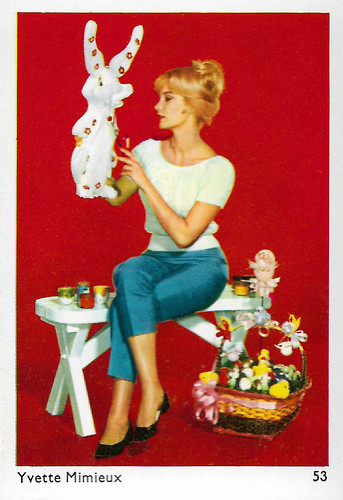
West-German collectors card, no. 53.
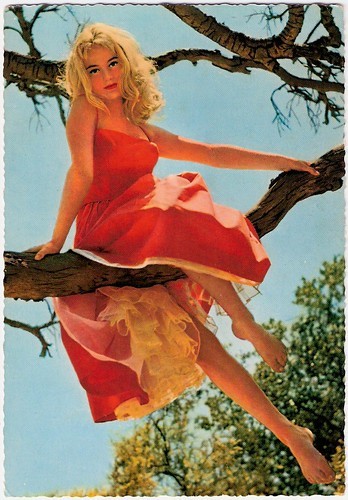
West-German postcard by Krüger, no. 902/370. Photo: Gérard Decaux.
800,000 years into the future
Yvette Carmen Mimieux was born in Los Angeles, California, in 1942. Her French father was René Mimieux and her Mexican mother Maria Montemayor. She has at least two siblings: sister Gloria and a brother.
The blonde, well-proportioned Mimieux was a beauty contest winner and model when talent manager Jim Byron suggested she become an actress. Her first acting appearances were in episodes of the television shows Yancy Derringer and One Step Beyond.
In 1960, she made her film debut, the Science Fiction film The Time Machine (George Pal, 1960). In George Pal's production of the H.G. Wells novel about time travel, Wells (Rod Taylor) travels 800,000 years into the future and falls for Weena (Mimieux) of the peaceful Eloi who are threatened by the Morlocks, cannibalistic mutations. The film was made for MGM, which put her under a long-term contract.
Her breakthrough role was followed by parts in Platinum High School (Charles Haas, 1960), with Mickey Rooney and Terry Moore , and the first beach-party movie, Where the Boys Are (Henry Levin, 1960) with George Hamilton.
Where the Boys Are was one of the first teen films to explore adolescent sexuality and the changing sexual morals and attitudes among American college youth. Aimed at the teen market, it inspired many American college students to head to Fort Lauderdale for their annual spring break.
MGM put Mimieux in the ingenue role in Four Horsemen of the Apocalypse (Vincente Minelli, 1961), an expensive flop. She had a central role in Light in the Piazza (Guy Green, 1962) with Olivia de Havilland, Rossano Brazzi , and George Hamilton, playing a mentally disabled girl. The film lost money but was well regarded critically.
She had a small part in The Wonderful World of the Brothers Grimm (George Pal, 1963), another commercial disappointment. Also later that year, she appeared in Diamond Head (Guy Green, 1963) for Columbia, billed second to Charlton Heston . She went to United Artists for Toys in the Attic (George Roy Hill, 1963), based on the play by Lillian Hellman and co-starring Dean Martin.
On TV, Mimieux guest-starred on two episodes of Dr. Kildare alongside Richard Chamberlain. Hal Erickson at AllMovie : "An appearance as a terminally ill girl on the 1964 Dr. Kildare episode 'Tyger Tyger' drew a great deal of press attention for Mimieux, principally because she spent most of her early scenes in a bikini. The actress's subsequent roles showed promise, but she generally found herself playing second fiddle to the leading man."
Mimieux made a cameo as herself in the comedy-musical Looking for Love (Don Weis, 1964) starring popular singer Connie Francis and played Richard Chamberlain's love interest in the romance Joy in the Morning (Alex Segal, 1965).
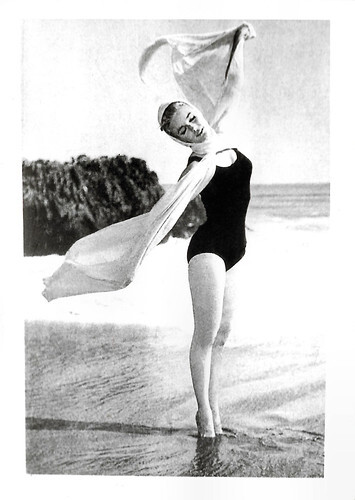
Small Dutch collectors card.
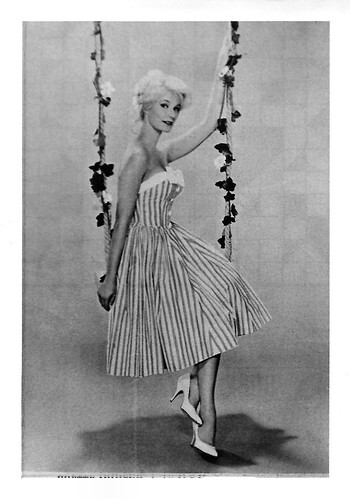
Small Dutch collectors card.
Unhappy with the "one-dimensional" roles offered to female actors
Post-MGM, Yvette Mimieux was in the Western The Reward (Serge Bourguignon, 1965) with Max von Sydow, the Disney comedy Monkeys, Go Home! (Andrew V. McLaglen, 1967) with Maurice Chevalier , and the heist film The Caper of the Golden Bulls (Russell Rouse, 1967) starring Stephen Boyd .
She was reunited with Rod Taylor in the action film Dark of the Sun (Jack Cardiff, 1968). Mimieux was top-billed in the hit Three in the Attic (Richard Wilson, 1969) with Christopher Lee , and appeared in the critically acclaimed film The Picasso Summer (Serge Bourguignon, Robert Sallin, 1969) alongside Albert Finney .
Mimieux was the female lead in the action film The Delta Factor (Tay Garnett, 1970), based on the 1967 novel by Mickey Spillane. She then had one of the leads in The Most Deadly Game (1970–1971), a short-lived TV series from Aaron Spelling.
Around this time Mimieux had a business selling Haitian products and she studied archeology and would travel several months of each year. In 1971 she sued her agent for not providing her with movie work despite taking money.
She was an air hostess in the disaster film Skyjacked (John Guillermin, 1972), starring Charlton Heston , and appeared in the Science-Fiction film The Neptune Factor (Daniel Petrie, 1973). By the early 1970s, Mimieux was unhappy with the 'one-dimensional' roles offered to female actors: "There's nothing to play. They're either sex objects or vanilla pudding.
Mimieux had been writing for several years, mostly journalism and short stories. She wrote a thriller, which she took to producers Aaron Spelling and Leonard Goldberg, who then produced it for ABC as a television film. It aired as Hit Lady (Tracy Keenan Wynn, 1974). Hal Erickson at AllMovie : "she is undeniably impressive as a scantily clad professional assassin".
Mimieux starred in The Legend of Valentino (Melville Shavelson, 1975), in which she played Rudolph Valentino 's ( Franco Nero ) second wife, Natacha Rambova. Also in 1975, she made the Canadian thriller Journey into Fear (Daniel Petrie, 1975), a remake of the spy film Journey into Fear (Norman Foster, 1943) starring Orson Welles .
Mimieux was a falsely imprisoned woman victimised by a sadistic guard in the exploitation film Jackson County Jail (Michael Miller, 1976) with Tommy Lee Jones. The 'drive-in' film has become a cult film and was selected by Quentin Tarantino for the first Quentin Tarantino Film Festival in Austin, Texas, in 1996.
Mimieux co-starred in the first PG-rated Walt Disney Productions feature, The Black Hole (Gary Nelson, 1979) starring Maximilian Schell and Anthony Perkins . She had the lead as the chief executive of a giant corporation called "Mystique" in Circle of Power (Bobby Roth, 1981).
She appeared in several TV movies and guest-starred on The Love Boat (1984), Lime Street (1985), and Perry Mason: The Case of the Desperate Deception (1990). Her last appearance was in the TV mini-series Lady Boss (Charles Jarrott, 1992), based on a novel written by Jackie Collins. After this role, she retired from acting.
Yvette Mimieux married three times. In 1959, she married Evan Harland Engber but kept the marriage secret for almost two years. She was married to film director Stanley Donen from 1972 until their divorce in 1985. In 1986, Mimieux married Howard F. Ruby, chairman emeritus and founder of Oakwood Worldwide.
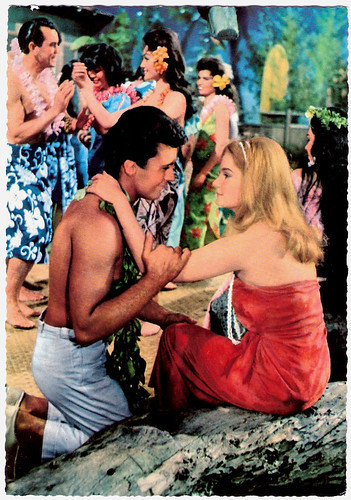
German postcard by Krüger, no. 902/254. Photo: Yvette Mimieux and James Darren in Diamond Head (Guy Green, 1963).
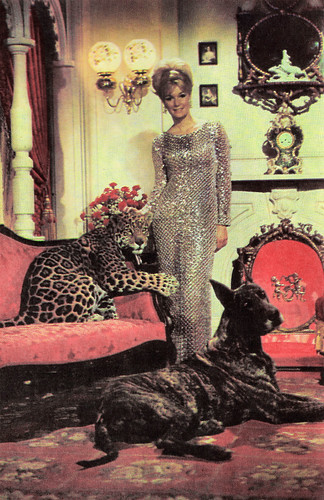
Romanian postcard by Casa Filmului Acin, no. 90.
Sources: Hal Erickson (AllMovie), Wikipedia, and .

West-German collectors card, no. 53.

West-German postcard by Krüger, no. 902/370. Photo: Gérard Decaux.
800,000 years into the future
Yvette Carmen Mimieux was born in Los Angeles, California, in 1942. Her French father was René Mimieux and her Mexican mother Maria Montemayor. She has at least two siblings: sister Gloria and a brother.
The blonde, well-proportioned Mimieux was a beauty contest winner and model when talent manager Jim Byron suggested she become an actress. Her first acting appearances were in episodes of the television shows Yancy Derringer and One Step Beyond.
In 1960, she made her film debut, the Science Fiction film The Time Machine (George Pal, 1960). In George Pal's production of the H.G. Wells novel about time travel, Wells (Rod Taylor) travels 800,000 years into the future and falls for Weena (Mimieux) of the peaceful Eloi who are threatened by the Morlocks, cannibalistic mutations. The film was made for MGM, which put her under a long-term contract.
Her breakthrough role was followed by parts in Platinum High School (Charles Haas, 1960), with Mickey Rooney and Terry Moore , and the first beach-party movie, Where the Boys Are (Henry Levin, 1960) with George Hamilton.
Where the Boys Are was one of the first teen films to explore adolescent sexuality and the changing sexual morals and attitudes among American college youth. Aimed at the teen market, it inspired many American college students to head to Fort Lauderdale for their annual spring break.
MGM put Mimieux in the ingenue role in Four Horsemen of the Apocalypse (Vincente Minelli, 1961), an expensive flop. She had a central role in Light in the Piazza (Guy Green, 1962) with Olivia de Havilland, Rossano Brazzi , and George Hamilton, playing a mentally disabled girl. The film lost money but was well regarded critically.
She had a small part in The Wonderful World of the Brothers Grimm (George Pal, 1963), another commercial disappointment. Also later that year, she appeared in Diamond Head (Guy Green, 1963) for Columbia, billed second to Charlton Heston . She went to United Artists for Toys in the Attic (George Roy Hill, 1963), based on the play by Lillian Hellman and co-starring Dean Martin.
On TV, Mimieux guest-starred on two episodes of Dr. Kildare alongside Richard Chamberlain. Hal Erickson at AllMovie : "An appearance as a terminally ill girl on the 1964 Dr. Kildare episode 'Tyger Tyger' drew a great deal of press attention for Mimieux, principally because she spent most of her early scenes in a bikini. The actress's subsequent roles showed promise, but she generally found herself playing second fiddle to the leading man."
Mimieux made a cameo as herself in the comedy-musical Looking for Love (Don Weis, 1964) starring popular singer Connie Francis and played Richard Chamberlain's love interest in the romance Joy in the Morning (Alex Segal, 1965).

Small Dutch collectors card.

Small Dutch collectors card.
Unhappy with the "one-dimensional" roles offered to female actors
Post-MGM, Yvette Mimieux was in the Western The Reward (Serge Bourguignon, 1965) with Max von Sydow, the Disney comedy Monkeys, Go Home! (Andrew V. McLaglen, 1967) with Maurice Chevalier , and the heist film The Caper of the Golden Bulls (Russell Rouse, 1967) starring Stephen Boyd .
She was reunited with Rod Taylor in the action film Dark of the Sun (Jack Cardiff, 1968). Mimieux was top-billed in the hit Three in the Attic (Richard Wilson, 1969) with Christopher Lee , and appeared in the critically acclaimed film The Picasso Summer (Serge Bourguignon, Robert Sallin, 1969) alongside Albert Finney .
Mimieux was the female lead in the action film The Delta Factor (Tay Garnett, 1970), based on the 1967 novel by Mickey Spillane. She then had one of the leads in The Most Deadly Game (1970–1971), a short-lived TV series from Aaron Spelling.
Around this time Mimieux had a business selling Haitian products and she studied archeology and would travel several months of each year. In 1971 she sued her agent for not providing her with movie work despite taking money.
She was an air hostess in the disaster film Skyjacked (John Guillermin, 1972), starring Charlton Heston , and appeared in the Science-Fiction film The Neptune Factor (Daniel Petrie, 1973). By the early 1970s, Mimieux was unhappy with the 'one-dimensional' roles offered to female actors: "There's nothing to play. They're either sex objects or vanilla pudding.
Mimieux had been writing for several years, mostly journalism and short stories. She wrote a thriller, which she took to producers Aaron Spelling and Leonard Goldberg, who then produced it for ABC as a television film. It aired as Hit Lady (Tracy Keenan Wynn, 1974). Hal Erickson at AllMovie : "she is undeniably impressive as a scantily clad professional assassin".
Mimieux starred in The Legend of Valentino (Melville Shavelson, 1975), in which she played Rudolph Valentino 's ( Franco Nero ) second wife, Natacha Rambova. Also in 1975, she made the Canadian thriller Journey into Fear (Daniel Petrie, 1975), a remake of the spy film Journey into Fear (Norman Foster, 1943) starring Orson Welles .
Mimieux was a falsely imprisoned woman victimised by a sadistic guard in the exploitation film Jackson County Jail (Michael Miller, 1976) with Tommy Lee Jones. The 'drive-in' film has become a cult film and was selected by Quentin Tarantino for the first Quentin Tarantino Film Festival in Austin, Texas, in 1996.
Mimieux co-starred in the first PG-rated Walt Disney Productions feature, The Black Hole (Gary Nelson, 1979) starring Maximilian Schell and Anthony Perkins . She had the lead as the chief executive of a giant corporation called "Mystique" in Circle of Power (Bobby Roth, 1981).
She appeared in several TV movies and guest-starred on The Love Boat (1984), Lime Street (1985), and Perry Mason: The Case of the Desperate Deception (1990). Her last appearance was in the TV mini-series Lady Boss (Charles Jarrott, 1992), based on a novel written by Jackie Collins. After this role, she retired from acting.
Yvette Mimieux married three times. In 1959, she married Evan Harland Engber but kept the marriage secret for almost two years. She was married to film director Stanley Donen from 1972 until their divorce in 1985. In 1986, Mimieux married Howard F. Ruby, chairman emeritus and founder of Oakwood Worldwide.

German postcard by Krüger, no. 902/254. Photo: Yvette Mimieux and James Darren in Diamond Head (Guy Green, 1963).

Romanian postcard by Casa Filmului Acin, no. 90.
Sources: Hal Erickson (AllMovie), Wikipedia, and .
Published on January 19, 2022 22:00
January 18, 2022
Batman (1989)
In the American fantasy film Batman (Tim Burton, 1989), the Dark Knight of Gotham City (Michael Keaton) begins his war on crime with his first major enemy being Jack Napier (Jack Nicholson), a criminal who becomes the clownishly homicidal Joker. The film was based on the DC Comics book series, which was started in 1939 by Bob Kane and Bill Finger. Batman was a huge box-office success, being the best-attended film of 1989. It was the first part of a cycle of Batman films, which later included Batman Returns (1992), Batman Forever (1995), and Batman & Robin (1997).
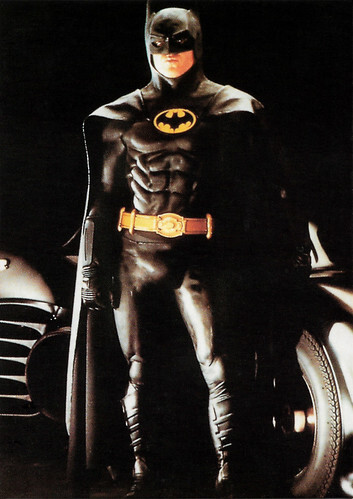
French postcard, no. 1118. Photo: Warner Bros. Inc. Michael Keaton in Batman (Tim Burton, 1989).
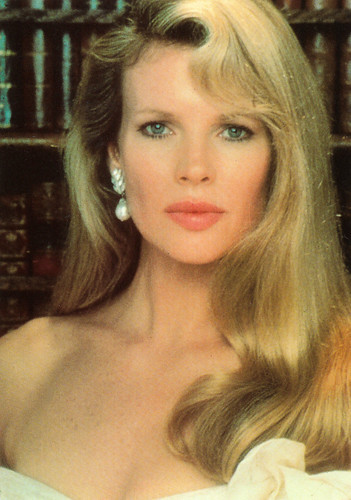
British postcard by Heroes Publishing Ltd., London, no. SPC2429. Kim Basinger in Batman (Tim Burton, 1989).
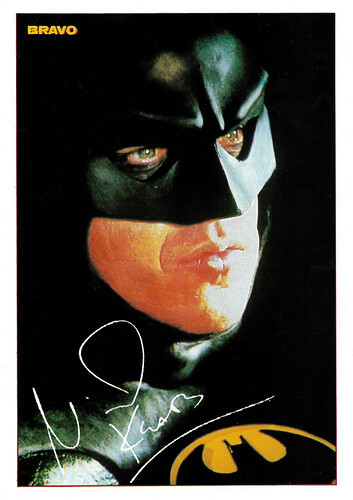
German autograph card by Bravo. Photo: Michael Keaton in Batman (Tim Burton, 1989).
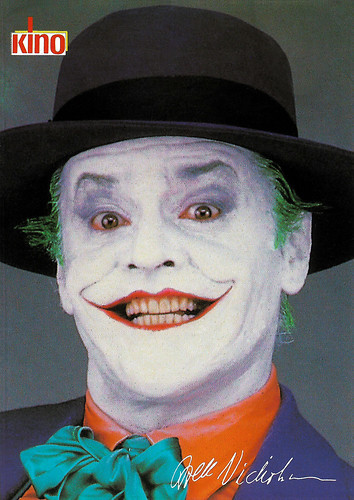
German autograph card by Kino. Photo: Jack Nicholson in Batman (Tim Burton, 1989).
There's a new crime fighter in town
The location of Batman (Tim Burton, 1989) is Gotham City - a big and very unsafe city. Crime boss Carl Grissom ( Jack Palance ) effectively runs the town but there's a new crime fighter in town - the mysterious Batman (Michael Keaton), a very capable fighter in a bat costume, on whom bullets seem to have little effect.
Grissom's right-hand man is Jack Napier ( Jack Nicholson ), a brutal man who is not entirely sane... Napier turns out to have a secret relationship with Grissom's mistress Alicia (Jerry Hall). Grissom learns of the affair and covertly informs the police of a robbery in order to have Napier eliminated.
Napier falls to his apparent death in a vat of chemicals. However, he soon reappears as The Joker and starts a reign of terror in Gotham City. Meanwhile, journalist Alexander Knox (Robert Wuhl) and photographer Vicki Vale ( Kim Basinger ) are in the city to do an article on Batman. Vicki soon starts a relationship with Batman's everyday persona, eccentric billionaire Bruce Wayne.
The idea of making a film about Batman came up in 1980. Tom Mankiewicz, who had co-written the screenplay for Superman (Richard Donner, 1978), wrote the first draft of a screenplay, in which the origin of Batman was told, with the Joker and Penguin as the bad guys. Robin would appear in costume at the end of the film.
The film was due for release in 1985 but was delayed until the project was picked up by producers Jon Peters and Peter Gruber. They recruited Tim Burton to direct after his film Pee-wee's Big Adventure (Tim Burton, 1985) became an unexpected success. Burton rewrote a revised version with his then-girlfriend Julie Hickson, and in 1986 commissioned Sam Hamm to write a new screenplay based on his changes.
In 1988, the project was given the green light after Burton's Beetlejuice (Tim Burton, 1988) proved to be a great success. In September 1988, the film went into production, and filming began in October. By December, the film was finished. Gotham City was designed by British designer Anton Furst. The bleak, urban set design was reminiscent of the sets of films like Metropolis (Fritz Lang, 1927) and Blade Runner (Ridley Scott, 1982).
Furst deliberately combined several architectural styles, so that Gotham City did not come from a clear period of time and the city appeared very ugly and desolate. When it was announced that the film was to be made, fans of the comic book series feared that the film would take on the light-hearted, farcical tone of the 1960s television series. The choice of Michael Keaton as Batman played a major role in this, as Keaton had until then been known mainly for his work in light film comedies.
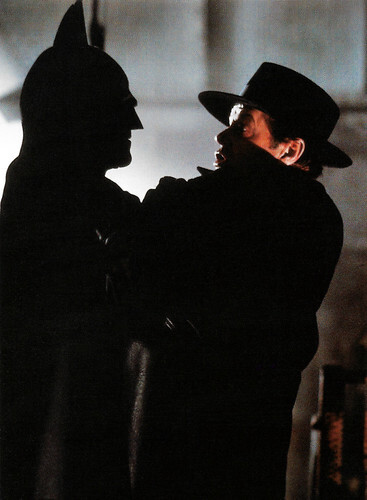
British postcard by Athena International, BAT, no. 10, 1989, no. 0334340. Photo: TM / DC Comics Inc. Michael Keaton and Jack Nicholson in Batman (Tim Burton, 1989).
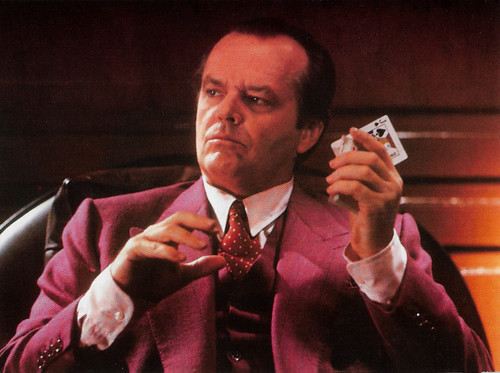
British postcard by Athena International, BAT, no. 11, 1989, no. 0334341. Photo: TM / DC Comics Inc. Jack Nicholson in Batman (Tim Burton, 1989).
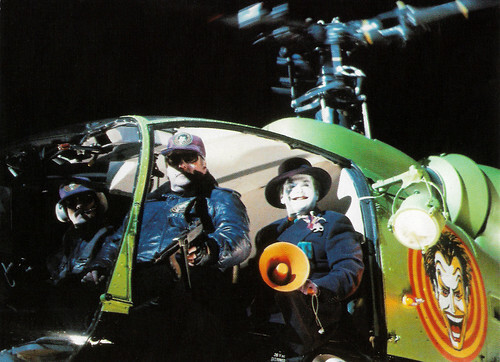
British postcard by Athena International, BAT, no. 12, 1989, no. 0334342. Photo: TM / DC Comics Inc. Jack Nicholson in Batman (Tim Burton, 1989).
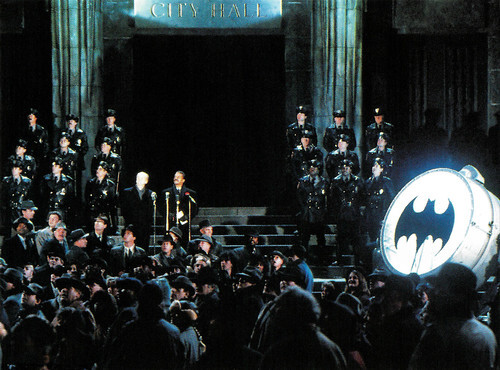
British postcard by Athena International, BAT, no. 15, 1989, no. 0334345. Photo: TM / DC Comics Inc. Billy Dee Williams in Batman (Tim Burton, 1989).
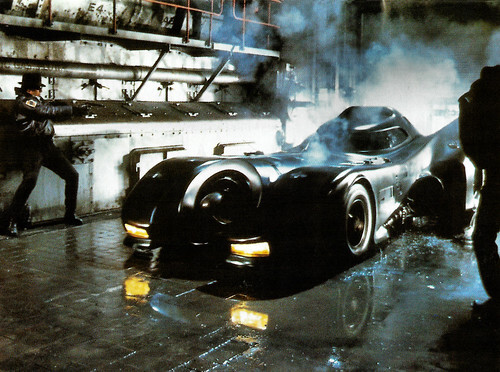
British postcard by Athena International, BAT, no. 16, 1989, no. 0334346. Photo: TM / DC Comics Inc. Publicity still for Batman (Tim Burton, 1989).
The Joker steals the show in every scene he's in
However, Batman (Tim Burton, 1989) proved faithful to the original comic series. The influence of Frank Miller's darker Batman comics, 'Batman: The Dark Knight Returns'(1986), was also evident.
Batman became a huge success, grossing $100 million in its first ten days and eventually grossing over $400 million worldwide. In North America alone, the film made about $82.8 million.
Still, there was some criticism. Roger Ebert wrote: "Batman is a triumph of design over story, style over substance - a great-looking movie with a plot you can’t care much about. All of the big moments in the movie are pounded home with ear-shattering sound effects and a jackhammer cutting style, but that just serves to underline the movie’s problem, which is a curious lack of suspense and intrinsic interest."
Leonard Maltin noted that the villain, the Joker, was a far more interesting character than the hero, Batman, and stole the show in every scene he was in. In addition to Burton's direction and special effects, the dramatic music score by Danny Elfman and the sombre, urban set design by Anton Furst and Peter Young were praised at the reception. Furst and Young received an Academy Award for best set design.
An extensive promotional campaign accompanied the film, including toys, T-shirts, buttons, postcards, and posters with the black and yellow bat logo. Two music albums were released, an official, instrumental version by Danny Elfman and an album by Prince with Batman and the Joker as the main theme, some of the songs of which were also featured in the film. Prince's music became a great success and reached the number one position in several countries, including the United States and the Netherlands. The song 'Batdance' also became a big hit. Both the film music by Elfman and a song by Prince, 'Partyman', were nominated for a Grammy Award.
Batman (1989) had three sequels: Batman Returns (1992), also directed by Tim Burton, Batman Forever (Joel Schumacher, 1995) with Val Kilmer as Batman, and Batman and Robin (Joel Schumacher, 1997), with George Clooney as the caped cruisader. It also inspired the animated series Batman (1992-1995).
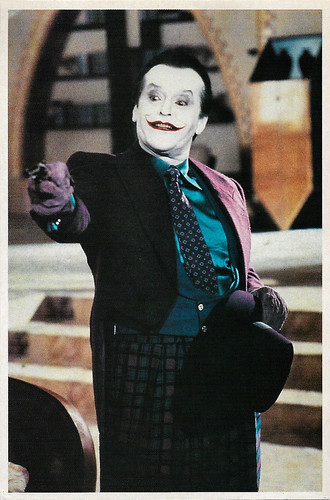
French postcard by Editions Mercuri, no. 87. Photo: Warner Bros Inc. Jack Nicholson in Batman (Tim Burton, 1989).
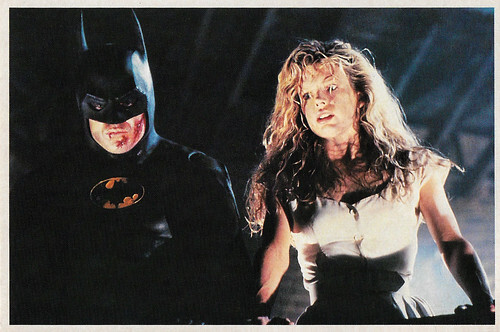
French postcard by Editions Mercuri, no. 88. Photo: Warner Bros Inc. Michael Keaton and Kim Basinger in Batman (Tim Burton, 1989).
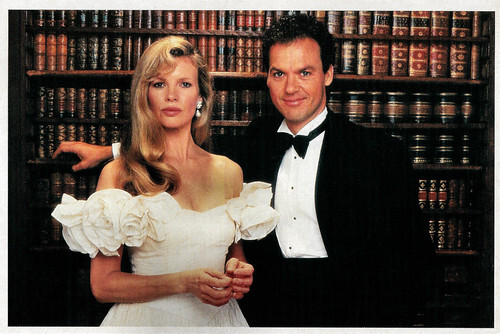
French postcard by Editions Mercuri, no. 89. Photo: Warner Bros. Inc. Kim Basinger and Michael Keaton in Batman (Tim Burton, 1989).
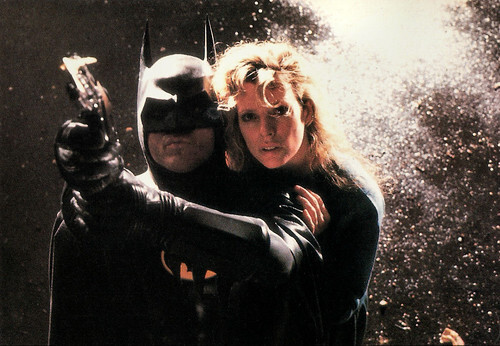
French postcard by Sonis, no. C 62. Photo: Warner Bros inc. Michael Keaton and Kim Basinger in Batman (Tim Burton, 1989).
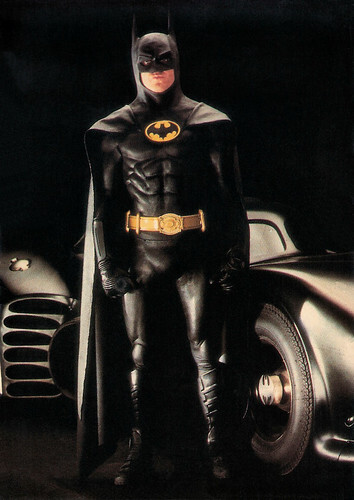
French postcard by Sonis, no. C 64. Photo: Warner Bros. Inc. Michael Keaton in Batman (Tim Burton, 1989).
Sources: Wikipedia (Dutch, French, and English) and IMDb.

French postcard, no. 1118. Photo: Warner Bros. Inc. Michael Keaton in Batman (Tim Burton, 1989).

British postcard by Heroes Publishing Ltd., London, no. SPC2429. Kim Basinger in Batman (Tim Burton, 1989).

German autograph card by Bravo. Photo: Michael Keaton in Batman (Tim Burton, 1989).

German autograph card by Kino. Photo: Jack Nicholson in Batman (Tim Burton, 1989).
There's a new crime fighter in town
The location of Batman (Tim Burton, 1989) is Gotham City - a big and very unsafe city. Crime boss Carl Grissom ( Jack Palance ) effectively runs the town but there's a new crime fighter in town - the mysterious Batman (Michael Keaton), a very capable fighter in a bat costume, on whom bullets seem to have little effect.
Grissom's right-hand man is Jack Napier ( Jack Nicholson ), a brutal man who is not entirely sane... Napier turns out to have a secret relationship with Grissom's mistress Alicia (Jerry Hall). Grissom learns of the affair and covertly informs the police of a robbery in order to have Napier eliminated.
Napier falls to his apparent death in a vat of chemicals. However, he soon reappears as The Joker and starts a reign of terror in Gotham City. Meanwhile, journalist Alexander Knox (Robert Wuhl) and photographer Vicki Vale ( Kim Basinger ) are in the city to do an article on Batman. Vicki soon starts a relationship with Batman's everyday persona, eccentric billionaire Bruce Wayne.
The idea of making a film about Batman came up in 1980. Tom Mankiewicz, who had co-written the screenplay for Superman (Richard Donner, 1978), wrote the first draft of a screenplay, in which the origin of Batman was told, with the Joker and Penguin as the bad guys. Robin would appear in costume at the end of the film.
The film was due for release in 1985 but was delayed until the project was picked up by producers Jon Peters and Peter Gruber. They recruited Tim Burton to direct after his film Pee-wee's Big Adventure (Tim Burton, 1985) became an unexpected success. Burton rewrote a revised version with his then-girlfriend Julie Hickson, and in 1986 commissioned Sam Hamm to write a new screenplay based on his changes.
In 1988, the project was given the green light after Burton's Beetlejuice (Tim Burton, 1988) proved to be a great success. In September 1988, the film went into production, and filming began in October. By December, the film was finished. Gotham City was designed by British designer Anton Furst. The bleak, urban set design was reminiscent of the sets of films like Metropolis (Fritz Lang, 1927) and Blade Runner (Ridley Scott, 1982).
Furst deliberately combined several architectural styles, so that Gotham City did not come from a clear period of time and the city appeared very ugly and desolate. When it was announced that the film was to be made, fans of the comic book series feared that the film would take on the light-hearted, farcical tone of the 1960s television series. The choice of Michael Keaton as Batman played a major role in this, as Keaton had until then been known mainly for his work in light film comedies.

British postcard by Athena International, BAT, no. 10, 1989, no. 0334340. Photo: TM / DC Comics Inc. Michael Keaton and Jack Nicholson in Batman (Tim Burton, 1989).

British postcard by Athena International, BAT, no. 11, 1989, no. 0334341. Photo: TM / DC Comics Inc. Jack Nicholson in Batman (Tim Burton, 1989).

British postcard by Athena International, BAT, no. 12, 1989, no. 0334342. Photo: TM / DC Comics Inc. Jack Nicholson in Batman (Tim Burton, 1989).

British postcard by Athena International, BAT, no. 15, 1989, no. 0334345. Photo: TM / DC Comics Inc. Billy Dee Williams in Batman (Tim Burton, 1989).

British postcard by Athena International, BAT, no. 16, 1989, no. 0334346. Photo: TM / DC Comics Inc. Publicity still for Batman (Tim Burton, 1989).
The Joker steals the show in every scene he's in
However, Batman (Tim Burton, 1989) proved faithful to the original comic series. The influence of Frank Miller's darker Batman comics, 'Batman: The Dark Knight Returns'(1986), was also evident.
Batman became a huge success, grossing $100 million in its first ten days and eventually grossing over $400 million worldwide. In North America alone, the film made about $82.8 million.
Still, there was some criticism. Roger Ebert wrote: "Batman is a triumph of design over story, style over substance - a great-looking movie with a plot you can’t care much about. All of the big moments in the movie are pounded home with ear-shattering sound effects and a jackhammer cutting style, but that just serves to underline the movie’s problem, which is a curious lack of suspense and intrinsic interest."
Leonard Maltin noted that the villain, the Joker, was a far more interesting character than the hero, Batman, and stole the show in every scene he was in. In addition to Burton's direction and special effects, the dramatic music score by Danny Elfman and the sombre, urban set design by Anton Furst and Peter Young were praised at the reception. Furst and Young received an Academy Award for best set design.
An extensive promotional campaign accompanied the film, including toys, T-shirts, buttons, postcards, and posters with the black and yellow bat logo. Two music albums were released, an official, instrumental version by Danny Elfman and an album by Prince with Batman and the Joker as the main theme, some of the songs of which were also featured in the film. Prince's music became a great success and reached the number one position in several countries, including the United States and the Netherlands. The song 'Batdance' also became a big hit. Both the film music by Elfman and a song by Prince, 'Partyman', were nominated for a Grammy Award.
Batman (1989) had three sequels: Batman Returns (1992), also directed by Tim Burton, Batman Forever (Joel Schumacher, 1995) with Val Kilmer as Batman, and Batman and Robin (Joel Schumacher, 1997), with George Clooney as the caped cruisader. It also inspired the animated series Batman (1992-1995).

French postcard by Editions Mercuri, no. 87. Photo: Warner Bros Inc. Jack Nicholson in Batman (Tim Burton, 1989).

French postcard by Editions Mercuri, no. 88. Photo: Warner Bros Inc. Michael Keaton and Kim Basinger in Batman (Tim Burton, 1989).

French postcard by Editions Mercuri, no. 89. Photo: Warner Bros. Inc. Kim Basinger and Michael Keaton in Batman (Tim Burton, 1989).

French postcard by Sonis, no. C 62. Photo: Warner Bros inc. Michael Keaton and Kim Basinger in Batman (Tim Burton, 1989).

French postcard by Sonis, no. C 64. Photo: Warner Bros. Inc. Michael Keaton in Batman (Tim Burton, 1989).
Sources: Wikipedia (Dutch, French, and English) and IMDb.
Published on January 18, 2022 22:00
January 17, 2022
Dorian Gray
Dorian Gray (1928-2011) was a very elegant Italian actress in films by Michelangelo Antonioni and Federico Fellini. She was also a sexy seductress in comedies with Totò. In 1965, Gray completely vanished from the public eye.

Italian postcard in the 'Hobby' series by Bromostampa, Milano, no. 1181/5310.
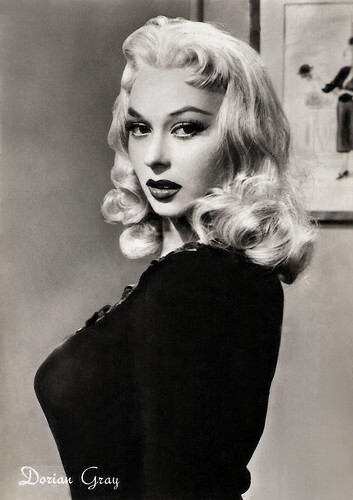
Italian postcard by Rotalfoto, Milano, no. 498. Photo: Vaselli.
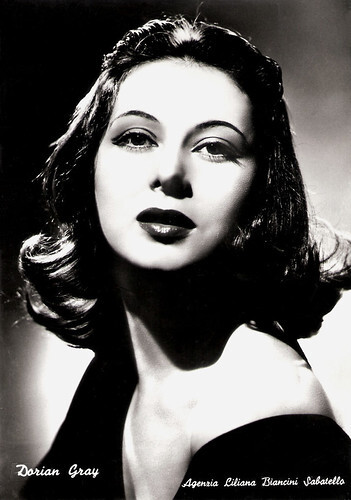
Italian postcard by Bromofoto, Milano, no. 1452. Photo: Agencia Liliana Biancini Sabatello.
Seductive Sex Kitten
Dorian Gray was born as Maria Luisa Mangini in Bolzano, South Tyrol, in 1928. She was the daughter of Attilio Mangini and Flora Divina. At the Scala Theatre in Milan, she studied dance with Aurel Millos.
In 1950, she made her stage debut in a show with Pina Renzi. The choreographer adviced her to take the stage name of Dorian Gray, of clear literary inspiration. She then moved on to the theatre and quickly became a known and acclaimed actress. However, after only five years she left the world of the theatre and devoted herself to the cinema.
In 1951, she already had made her film debut in the crime drama Amo un assassin/Appointment for Murder (Baccio Bandini, 1951) with Delia Scala .
The role she played most often in films was that of a seductive sex kitten in comedies like Totò, Peppino e la malafemmina/Toto, Peppino, and the Hussy (Camillo Mastrocinque, 1956). Gray appears as a variety dancer who falls in love with the nephew of Totò and Peppino De Filippo (played by Teddy Reno). It was the top-grossing film of the year in Italy and is now considered as one of the classics of Italian comedy.
On the wave of the success of this film, she acted in two other films with Totò , also directed by Camillo Mastrocinque: Totò lascia o raddoppia/Does Totò leave or double? (Camillo Mastrocinque, 1956) and Totò , Peppino e i fuorilegge/Totò, Peppino and the outlaws (Camillo Mastrocinque, 1956). For this film, Peppino De Filippo was awarded a Silver Ribbon for Best Supporting Actor.
The following year, she had the chance to demonstrate her dramatic talents as the petrol station attendant Virginia in Michelangelo Antonioni's Il grido/The Cry (1957). She co-starred with Steve Cochran , Alida Valli, and Betsy Blair to great critical acclaim. With this role she moved away from the image of the sensous, sexy blonde.
At the peak of her popularity, she also took part as Jessy, Amedeo Nazzari's lover in Le notti di Cabiria/Nights of Cabiria (Federico Fellini, 1957) featuring Giulietta Masina . The film was loaded with awards, including an Oscar for Best Foreign Language Film in 1958. For the film Mogli pericolose/Dangerous wives (Luigi Comencini, 1958), Dorian Gray herself was rewarded with a Nastro d'Argento as Best Supporting Actress.
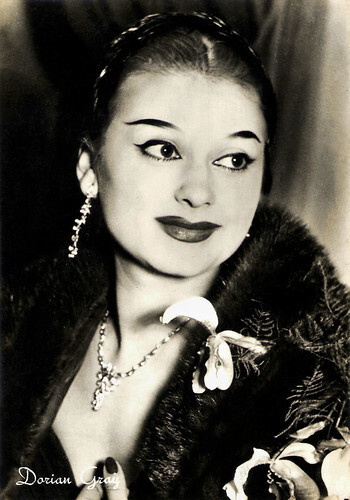
Italian postcard by Rotalfoto, Milano, no. 268.
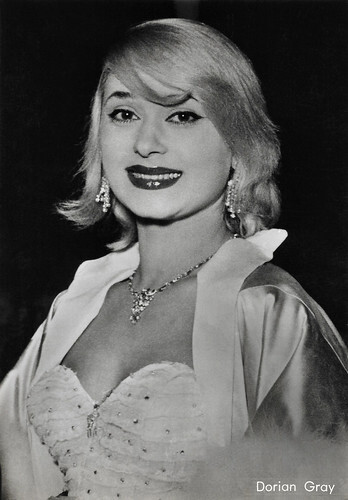
Italian postcard, no. 159.
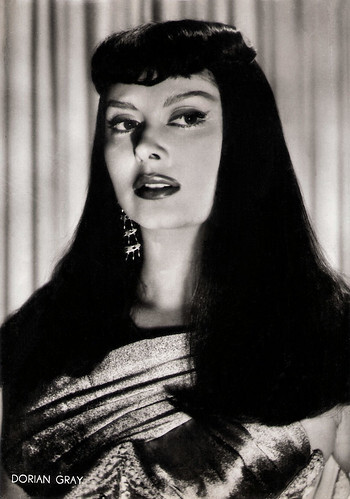
Italian postcard by Bromostampa, Milano, no. 382.
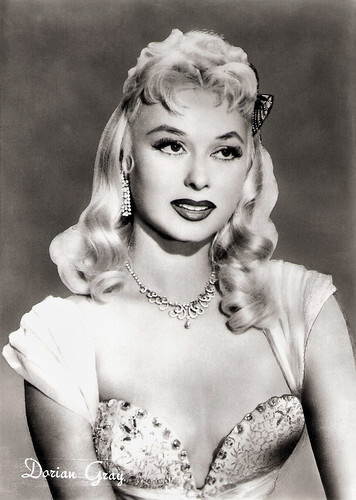
Italian postcard by Rotalfoto, Milano, no. 466. Photo: Vaselli.
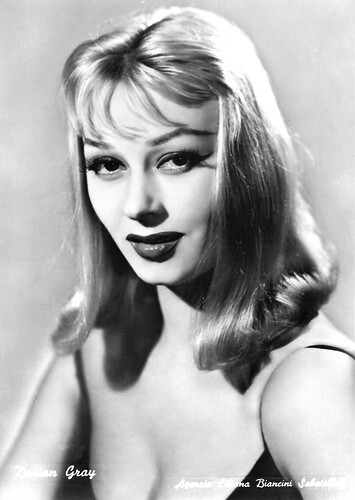
Italian postcard by Bromofoto, Milano, no. 1406. Photo: Agencia Liliana Biancini Sabatello.
Suicide by gunshot
After 1958, Dorian Gray made several more films, but none ever had the shine of her works of 1956, 1957 and 1958. She became romantically involved with Arturo Tofanelli, journalist and editor of the magazine Tempo, who over the years dedicated many covers to Dorian Gray. Tofanelli also helped the diva's career by producing or co-producing several films in which she was one of the protagonists.
She starred with Vittorio Gassman in the comedy Il mattatore/Love and Larceny (Dino Risi, 1960). She also played in one of the Peplums of that era, La regina delle Amazzoni/Colossus and the Amazons (Vittorio Sala, 1960) In this satirical Sword and Sandal comedy she starred opposite two actors imported from America, Rod Taylor, and bodybuilder Ed Fury.
She was among the all-star cast of the whodunit-comedy Crimen/...And Suddenly It's Murder! (Mario Camerini, 1960). She played the love interest of Foreign Legion captain Stewart Granger in the international production, Marcia o crepa/Commando (Frank Wisbar, 1962). This action-drama was the first film to deal explicitly with the Algerian war.
After that, she acted in numerous comedies and spy films until the mid-1960s. After the birth of her son with Tofanelli, Massimo Arturo Tofanelli, she retired from acting completely. In 1965, her final film was released, Fango sulla metropolis/City Criminals (Gino Mangini, 1965) with Tony Kendall. Gray never made another public appearance.
In 2011, Dorian Gray committed suicide by gunshot at her home in Torcegno, Italy. She was 83 years old. At the time, the media, however, reported her age as 75, since she herself always claimed to have been born in 1936.
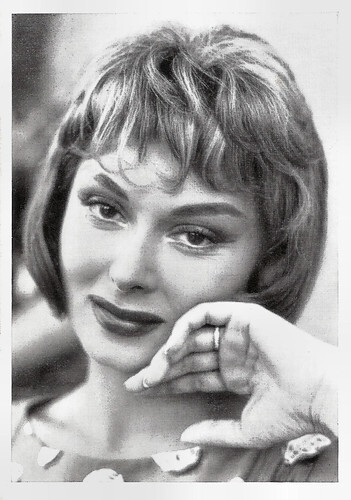
German cigarette card. Photo: Frontini.
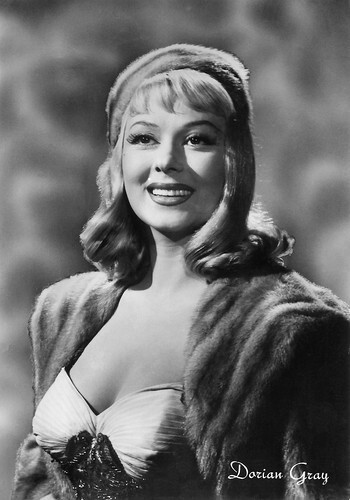
Italian postcard by Rotalfoto, Milano, no. 647 Photo: Titanus. Dorian Gray in Totò lascia o raddoppia/Does Totò leave or double? (Camillo Mastrocinque, 1956).
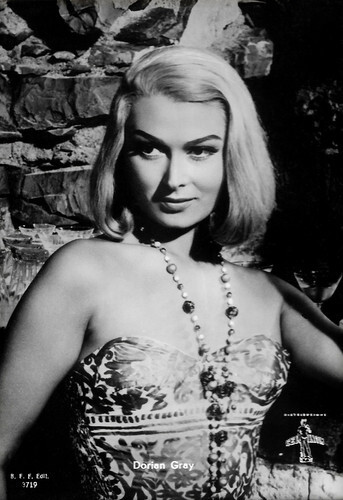
Italian postcard by B.F.F. (Ballerini & Fratini, Firenze) Edit., no. 3719 Photo: G.B. Poletto / Compagnia Edizioni Internazionali Artistiche Distribuzione (CEIAD). Dorian Gray in Racconti d'Estate/Girls for the Summer (Gianni Franciolini, 1958).
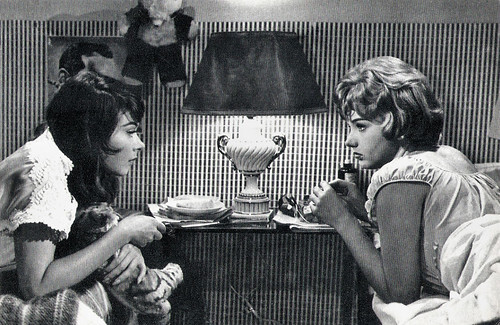
Romanian postcard by Casa Filmului Acin. Photo: Dorian Gray and Sylva Koscina in Le sorprese dell'amore/Surprise of Love (Luigi Comencini, 1959). At the flip side of the card the actress with Koscina is mistakenly identified as Anna-Maria Ferrero .
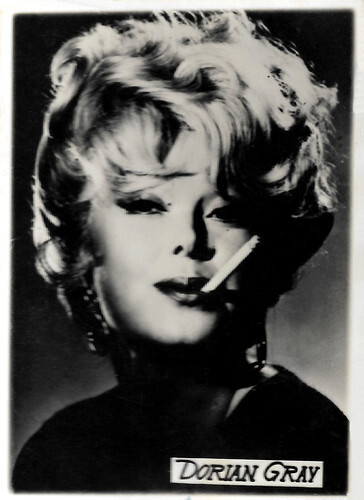
Small Romanian collectors card.
Sources: AllMovie, Wikipedia (English and Italian), and .

Italian postcard in the 'Hobby' series by Bromostampa, Milano, no. 1181/5310.

Italian postcard by Rotalfoto, Milano, no. 498. Photo: Vaselli.

Italian postcard by Bromofoto, Milano, no. 1452. Photo: Agencia Liliana Biancini Sabatello.
Seductive Sex Kitten
Dorian Gray was born as Maria Luisa Mangini in Bolzano, South Tyrol, in 1928. She was the daughter of Attilio Mangini and Flora Divina. At the Scala Theatre in Milan, she studied dance with Aurel Millos.
In 1950, she made her stage debut in a show with Pina Renzi. The choreographer adviced her to take the stage name of Dorian Gray, of clear literary inspiration. She then moved on to the theatre and quickly became a known and acclaimed actress. However, after only five years she left the world of the theatre and devoted herself to the cinema.
In 1951, she already had made her film debut in the crime drama Amo un assassin/Appointment for Murder (Baccio Bandini, 1951) with Delia Scala .
The role she played most often in films was that of a seductive sex kitten in comedies like Totò, Peppino e la malafemmina/Toto, Peppino, and the Hussy (Camillo Mastrocinque, 1956). Gray appears as a variety dancer who falls in love with the nephew of Totò and Peppino De Filippo (played by Teddy Reno). It was the top-grossing film of the year in Italy and is now considered as one of the classics of Italian comedy.
On the wave of the success of this film, she acted in two other films with Totò , also directed by Camillo Mastrocinque: Totò lascia o raddoppia/Does Totò leave or double? (Camillo Mastrocinque, 1956) and Totò , Peppino e i fuorilegge/Totò, Peppino and the outlaws (Camillo Mastrocinque, 1956). For this film, Peppino De Filippo was awarded a Silver Ribbon for Best Supporting Actor.
The following year, she had the chance to demonstrate her dramatic talents as the petrol station attendant Virginia in Michelangelo Antonioni's Il grido/The Cry (1957). She co-starred with Steve Cochran , Alida Valli, and Betsy Blair to great critical acclaim. With this role she moved away from the image of the sensous, sexy blonde.
At the peak of her popularity, she also took part as Jessy, Amedeo Nazzari's lover in Le notti di Cabiria/Nights of Cabiria (Federico Fellini, 1957) featuring Giulietta Masina . The film was loaded with awards, including an Oscar for Best Foreign Language Film in 1958. For the film Mogli pericolose/Dangerous wives (Luigi Comencini, 1958), Dorian Gray herself was rewarded with a Nastro d'Argento as Best Supporting Actress.

Italian postcard by Rotalfoto, Milano, no. 268.

Italian postcard, no. 159.

Italian postcard by Bromostampa, Milano, no. 382.

Italian postcard by Rotalfoto, Milano, no. 466. Photo: Vaselli.

Italian postcard by Bromofoto, Milano, no. 1406. Photo: Agencia Liliana Biancini Sabatello.
Suicide by gunshot
After 1958, Dorian Gray made several more films, but none ever had the shine of her works of 1956, 1957 and 1958. She became romantically involved with Arturo Tofanelli, journalist and editor of the magazine Tempo, who over the years dedicated many covers to Dorian Gray. Tofanelli also helped the diva's career by producing or co-producing several films in which she was one of the protagonists.
She starred with Vittorio Gassman in the comedy Il mattatore/Love and Larceny (Dino Risi, 1960). She also played in one of the Peplums of that era, La regina delle Amazzoni/Colossus and the Amazons (Vittorio Sala, 1960) In this satirical Sword and Sandal comedy she starred opposite two actors imported from America, Rod Taylor, and bodybuilder Ed Fury.
She was among the all-star cast of the whodunit-comedy Crimen/...And Suddenly It's Murder! (Mario Camerini, 1960). She played the love interest of Foreign Legion captain Stewart Granger in the international production, Marcia o crepa/Commando (Frank Wisbar, 1962). This action-drama was the first film to deal explicitly with the Algerian war.
After that, she acted in numerous comedies and spy films until the mid-1960s. After the birth of her son with Tofanelli, Massimo Arturo Tofanelli, she retired from acting completely. In 1965, her final film was released, Fango sulla metropolis/City Criminals (Gino Mangini, 1965) with Tony Kendall. Gray never made another public appearance.
In 2011, Dorian Gray committed suicide by gunshot at her home in Torcegno, Italy. She was 83 years old. At the time, the media, however, reported her age as 75, since she herself always claimed to have been born in 1936.

German cigarette card. Photo: Frontini.

Italian postcard by Rotalfoto, Milano, no. 647 Photo: Titanus. Dorian Gray in Totò lascia o raddoppia/Does Totò leave or double? (Camillo Mastrocinque, 1956).

Italian postcard by B.F.F. (Ballerini & Fratini, Firenze) Edit., no. 3719 Photo: G.B. Poletto / Compagnia Edizioni Internazionali Artistiche Distribuzione (CEIAD). Dorian Gray in Racconti d'Estate/Girls for the Summer (Gianni Franciolini, 1958).

Romanian postcard by Casa Filmului Acin. Photo: Dorian Gray and Sylva Koscina in Le sorprese dell'amore/Surprise of Love (Luigi Comencini, 1959). At the flip side of the card the actress with Koscina is mistakenly identified as Anna-Maria Ferrero .

Small Romanian collectors card.
Sources: AllMovie, Wikipedia (English and Italian), and .
Published on January 17, 2022 22:00
January 16, 2022
Michel Subor (1935-2022)
Today, 17 January 2022, Michel Subor (1935) passed away. The French actor gained initial fame with the starring role in Jean-Luc Godard's second feature, Le Petit Soldat (1960). He acted in a couple of American films, including Alfred Hitchcock's Topaz (1969) as Claude Jade's husband. In 1999, he played Forestier in Beau Travail, a highly praised variation of Billy Budd, directed by Claire Denis. He continued to work with her. Subor was 86.
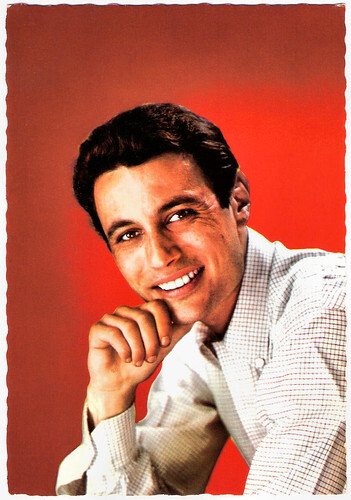
French postcard by E.D.U.G., no. 164. Photo: Sam Lévin.
Brigitte Bardot's lover
Michel Subor was born Mischa Subotzki in Paris, France in 1935, to anti-Bolshevik parents from the Soviet Union who had immigrated a few years earlier. His father was an engineer in Moscow, and his mother was born in Azerbaijan. Michel Subor has a sister who moved to the United States as an adult.
His career started with small roles in Frou-Frou (Augusto Genina, 1955) with Dany Robin , and the comedy Un drôle de dimanche/A Strange Sunday (Marc Allégret, 1958), followed by playing Jean Richard's son in the comedy Mon pote le gitan/My buddy the Gypsy (François Gir, Guy Lionel, 1959).
He had his first leading role as the lover of Brigitte Bardot 's character in the sexy comedy La Bride sur le Cou/Please, Not Now! (Roger Vadim, 1961).
The year before Subor had completed his most important early role in Jean-Luc Godard 's Le Petit Soldat/The Little Soldier (1960). The film was banned from release in France for three years because it refers to the use of torture on both the French and Algerian sides during the Algerian struggle for independence. Subor plays Bruno Forestier, a young, disillusioned man who becomes involved in politics, yet in spite of the fact that he stands up to torture and commits murder because of this involvement, he does not have deep political beliefs.
Subor also provided the narrator's voice in another classic of the Nouvelle Vague, Jules et Jim (François Truffaut, 1962).
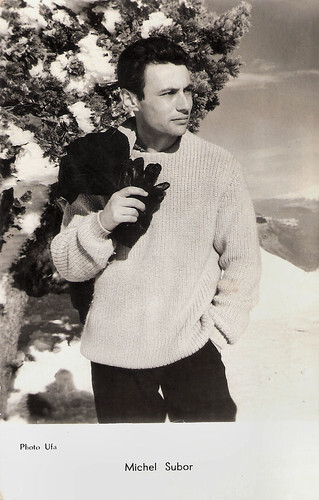
French postcard by Editions P.I., Paris, no. FK 89. Photo: Ufa.
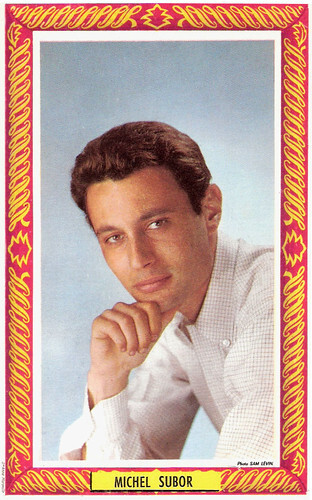
French postcard by Ste. Anne, Marseille. Photo: Sam Lévin.
Claude Jade's husband
Michel Subor worked with the director Paul Gégauff in Le reflux/The Reflux (1965), adapted from a novel by Robert Louis Stevenson. But the producer had not acquired the rights and the film was left unfinished.
Subor was also cast in some American films. He appeared in Clive Donner's comedy What's New, Pussycat? (1965) alongside Peter Sellers , Peter O'Toole , and Woody Allen. Later, he starred in Alfred Hitchcock 's Cold War-themed thriller Topaz (1969), as the journalist François Picard, the husband of Claude Jade .
Subor spent the next three decades focusing on his television career, starring in many French series and TV movies. In the cinema, he appeared in Jean-Louis Bertucelli's drama L'imprécateur/The Imprecator (1977) and Gérard Blain 's Le rebelle/The Rebel (1980) but felt he never made the transition to mainstream cinema. Blain used Subor again in Amen he (1999).
That year's renewal of Subor's career included a role in Claire Denis's psychological military drama Beau Travail, as a Foreign Legion captain named Bruno Forestier. Denis named his character after the role he played in the Godard film. Her variation of 'Billy Budd', set in Djibouti on the Red Sea, received high praise.
Jonathan Crow at AllMovie : "Within the film's elegant opening montage, Denis sets up the French Legion's estrangement to Djibouti's harsh landscape, and the French empire's estrangement from its distant, glorious past. Denis details obsessively not only the rituals of military life but the half-naked bodies of the legionnaires in a manner that both recalls and obliquely mocks Leni Riefenstahl . The constant motif of the male form also sets up the homoerotic tension between Galoup (Denis Lavant), Commanding Office Bruno Forestier (Michel Subor), and underling Sentain (Gregoire Colin)."
The next year he was in Sauvage Innocence/Wild Innocence (Philippe Garrel, 2000). Subor has since worked with Denis on L'Intrus/The Intruder (2005), White Material (2009), starring Isabelle Huppert , and Les Salauds/Bastards (2013) with Vincent Lindon and Chiara Mastroianni.
Michel Subor died in a traffic collision on 17 January 2022, at the age of 86.
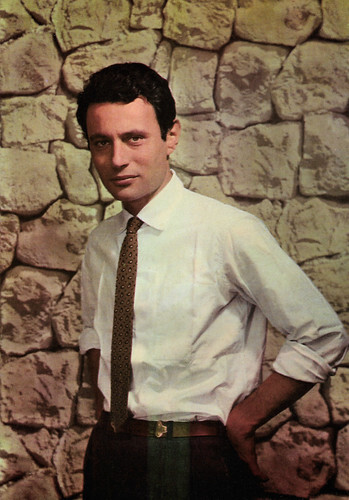
Spanish postcard by Oscar-Cine, Hospitalet (Barcelona).
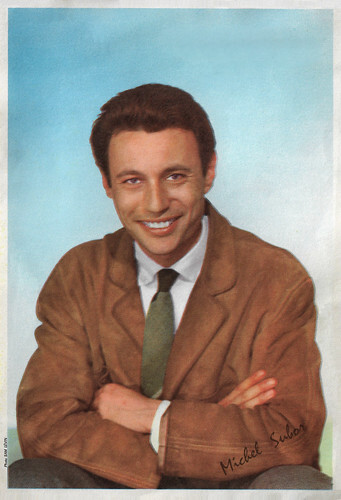
Big French card. Photo: Sam Lévin.
Sources: Jonathan Crow (AllMovie), Wikipedia, and .

French postcard by E.D.U.G., no. 164. Photo: Sam Lévin.
Brigitte Bardot's lover
Michel Subor was born Mischa Subotzki in Paris, France in 1935, to anti-Bolshevik parents from the Soviet Union who had immigrated a few years earlier. His father was an engineer in Moscow, and his mother was born in Azerbaijan. Michel Subor has a sister who moved to the United States as an adult.
His career started with small roles in Frou-Frou (Augusto Genina, 1955) with Dany Robin , and the comedy Un drôle de dimanche/A Strange Sunday (Marc Allégret, 1958), followed by playing Jean Richard's son in the comedy Mon pote le gitan/My buddy the Gypsy (François Gir, Guy Lionel, 1959).
He had his first leading role as the lover of Brigitte Bardot 's character in the sexy comedy La Bride sur le Cou/Please, Not Now! (Roger Vadim, 1961).
The year before Subor had completed his most important early role in Jean-Luc Godard 's Le Petit Soldat/The Little Soldier (1960). The film was banned from release in France for three years because it refers to the use of torture on both the French and Algerian sides during the Algerian struggle for independence. Subor plays Bruno Forestier, a young, disillusioned man who becomes involved in politics, yet in spite of the fact that he stands up to torture and commits murder because of this involvement, he does not have deep political beliefs.
Subor also provided the narrator's voice in another classic of the Nouvelle Vague, Jules et Jim (François Truffaut, 1962).

French postcard by Editions P.I., Paris, no. FK 89. Photo: Ufa.

French postcard by Ste. Anne, Marseille. Photo: Sam Lévin.
Claude Jade's husband
Michel Subor worked with the director Paul Gégauff in Le reflux/The Reflux (1965), adapted from a novel by Robert Louis Stevenson. But the producer had not acquired the rights and the film was left unfinished.
Subor was also cast in some American films. He appeared in Clive Donner's comedy What's New, Pussycat? (1965) alongside Peter Sellers , Peter O'Toole , and Woody Allen. Later, he starred in Alfred Hitchcock 's Cold War-themed thriller Topaz (1969), as the journalist François Picard, the husband of Claude Jade .
Subor spent the next three decades focusing on his television career, starring in many French series and TV movies. In the cinema, he appeared in Jean-Louis Bertucelli's drama L'imprécateur/The Imprecator (1977) and Gérard Blain 's Le rebelle/The Rebel (1980) but felt he never made the transition to mainstream cinema. Blain used Subor again in Amen he (1999).
That year's renewal of Subor's career included a role in Claire Denis's psychological military drama Beau Travail, as a Foreign Legion captain named Bruno Forestier. Denis named his character after the role he played in the Godard film. Her variation of 'Billy Budd', set in Djibouti on the Red Sea, received high praise.
Jonathan Crow at AllMovie : "Within the film's elegant opening montage, Denis sets up the French Legion's estrangement to Djibouti's harsh landscape, and the French empire's estrangement from its distant, glorious past. Denis details obsessively not only the rituals of military life but the half-naked bodies of the legionnaires in a manner that both recalls and obliquely mocks Leni Riefenstahl . The constant motif of the male form also sets up the homoerotic tension between Galoup (Denis Lavant), Commanding Office Bruno Forestier (Michel Subor), and underling Sentain (Gregoire Colin)."
The next year he was in Sauvage Innocence/Wild Innocence (Philippe Garrel, 2000). Subor has since worked with Denis on L'Intrus/The Intruder (2005), White Material (2009), starring Isabelle Huppert , and Les Salauds/Bastards (2013) with Vincent Lindon and Chiara Mastroianni.
Michel Subor died in a traffic collision on 17 January 2022, at the age of 86.

Spanish postcard by Oscar-Cine, Hospitalet (Barcelona).

Big French card. Photo: Sam Lévin.
Sources: Jonathan Crow (AllMovie), Wikipedia, and .
Published on January 16, 2022 22:00
Finding Nemo (2003)
Finding Nemo (Andrew Stanton, Lee Unkrich, 2003) is the fifth full-length animated film by Pixar, distributed by Walt Disney Pictures. It tells the story of an overprotective clownfish named Marlin who, along with a regal blue tang named Dory, searches for his missing son Nemo. Along the way, Marlin learns to take risks and comes to terms with Nemo taking care of himself. The film was a huge success and received more than thirty awards, including an Oscar for Best Animated Feature. Finding Nemo was a huge box-office success worldwide, earning nearly $865 million.
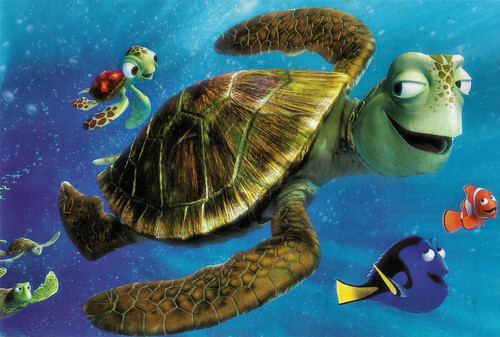
American postcard by Disney Enterprises / Pixar Animation Studios, 2005. Image: Pixar Animation Studios. Film image of Finding Nemo (Andrew Stanton, Lee Unkrich, 2003). From 'The Art of Pixar: 100 Collectible Postcards', published by Chronicle Books.
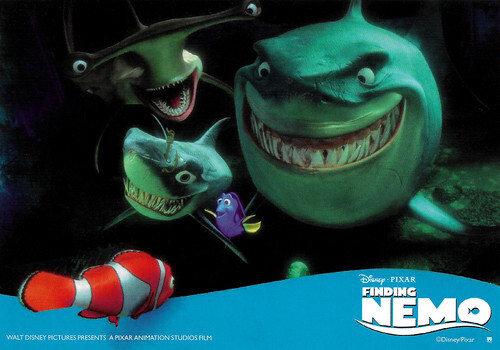
French postcard by Sonis, no. C. 1413, offered by Teisseire. Image: Disney / Pixar. Film image of Finding Nemo (Andrew Stanton, Lee Unkrich, 2003).
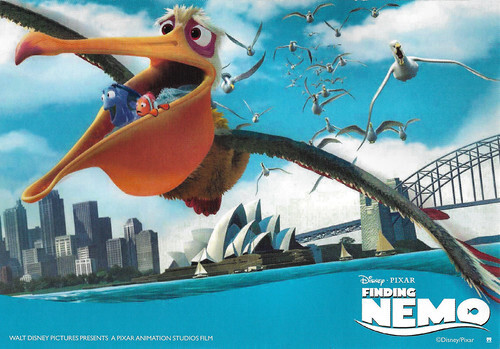
French postcard by Sonis, no. C. 1414. Image: Disney / Pixar. Film image of Finding Nemo (Andrew Stanton, Lee Unkrich, 2003).
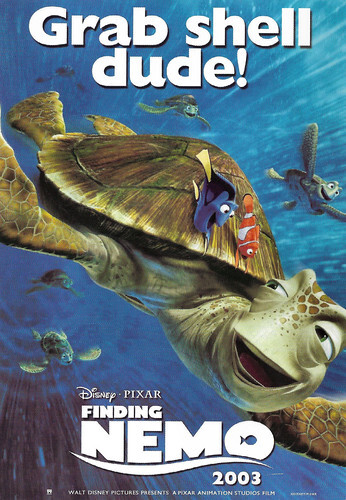
French postcard by Sonis, no. C. 1439. Image: Disney / Pixar. Film image of Finding Nemo (Andrew Stanton, Lee Unkrich, 2003). Caption: Grab shell dude!
An overprotective clownfish called Marlin
At the beginning of Finding Nemo (2003), the clownfish Marlin and his wife Coralie have just moved to a new anemone in the Great Barrier Reef. Their happiness is short-lived as Coralie and almost all the eggs she had laid are devoured by a barracuda. Only one egg survives.
Marlin decides to name the little fish from this egg Nemo, a name that Coralie had thought up. In Latin, the word 'nemo' means 'nobody' or 'no one'. It is also a reference to Captain Nemo in Jules Verne's novel '20,000 Leagues Under the Sea'.
Nemo has one fin that is smaller than normal. His father and he call it Nemo's lucky fin. It is actually a kind of scar from the barracuda's attack. The incident also makes Marlin excessively neurotic and protective of Nemo.
When Nemo is older, it is time for him to go to school. The timid Marlin follows Nemo, against his will, to make absolutely sure he is safe. Nemo has clearly had it with his father's behaviour. To prove there is no danger, he leaves the coral reef. However, he is spotted by two divers. One of them catches Nemo in a net and takes him away.
Marlin gets over his fear of the open sea to retrieve Nemo. He meets Dory, a blue tang suffering from short-term memory loss. One of the divers has lost his goggles, and Marlin finds them. The address of the diver is written on the goggles. With the help of Dory, who can read, they find out that Nemo is in Sydney now.
Dory accompanies Marlin to Sydney on his search for Nemo. The two come across, among other things, three vegetarian sharks, a school of jellyfish, and a group of sea turtles. The latter help them a great deal. Finally, Marlin and Dory are swallowed by a humpback whale that blows them out through the blowhole, which carries them the last mile to Sydney.
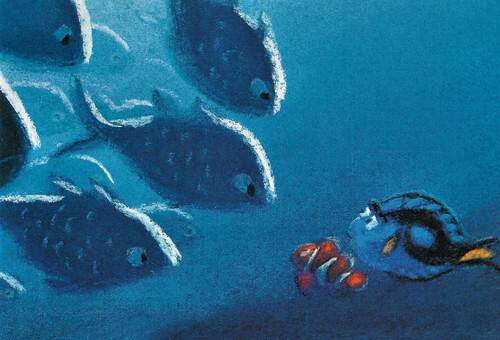
American postcard by Disney Enterprises / Pixar Animation Studios, 2005. Image: Pixar Animation Studios. Concept art by Ralph Eggleston for Finding Nemo (Andrew Stanton, Lee Unkrich, 2003). From 'The Art of Pixar: 100 Collectible Postcards', published by Chronicle Books.
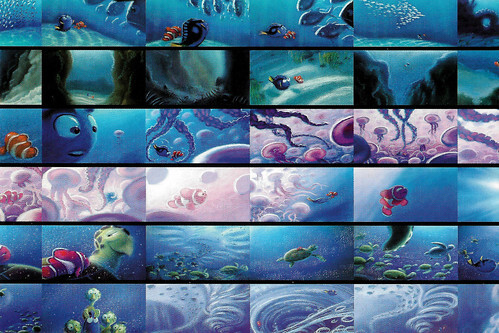
American postcard by Disney Enterprises / Pixar Animation Studios, 2005. Image: Pixar Animation Studios. Concept art by Ralph Eggleston for Finding Nemo (Andrew Stanton, Lee Unkrich, 2003). From 'The Art of Pixar: 100 Collectible Postcards', published by Chronicle Books.
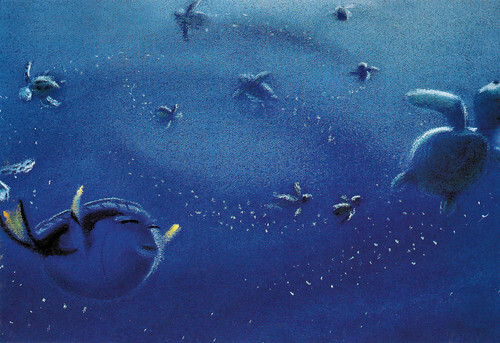
American postcard by Disney Enterprises / Pixar Animation Studios, 2005. Image: Pixar Animation Studios. Concept art by Ralph Eggleston for Finding Nemo (Andrew Stanton, Lee Unkrich, 2003). From 'The Art of Pixar: 100 Collectible Postcards', published by Chronicle Books.
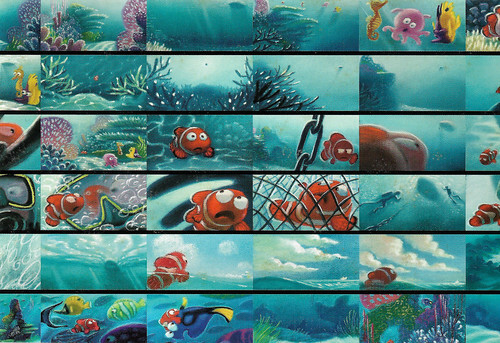
American postcard by Disney Enterprises / Pixar Animation Studios, 2005. Image: Pixar Animation Studios. Concept art by Ralph Eggleston for Finding Nemo (Andrew Stanton, Lee Unkrich, 2003). From 'The Art of Pixar: 100 Collectible Postcards', published by Chronicle Books.
One of those rare movies where I wanted to sit in the front row
The inspiration for Finding Nemo (2003) sprang from multiple experiences, going back to director Andrew Stanton's childhood, when he loved going to the dentist to see the fish tank, assuming that the fish were from the ocean and wanted to go home. In 1992, shortly after his son was born, he and his family took a trip to Six Flags Discovery Kingdom which was called Marine World at the time. There, after seeing the shark tube and various exhibits, he felt that the underwater world could be done beautifully in computer animation.
Later, in 1997, he took his son for a walk in the park but realized that he was overprotecting him and lost an opportunity to have a father-son experience that day. In an interview with National Geographic magazine, Stanton said that the idea for the characters of Marlin and Nemo came from a photograph of two clownfish peeking out of an anemone: "It was so arresting. I had no idea what kind of fish they were, but I couldn't take my eyes off them. And as an entertainer, the fact that they were called clownfish - it was perfect. There's almost nothing more appealing than these little fish that want to play peekaboo with you."
In addition, clownfish are colourful, but do not tend to come out of an anemone often. For a character who has to go on a dangerous journey, Stanton felt a clownfish was the perfect type of fish for the character. Pre-production of the film began in early 1997. Stanton began writing the screenplay during the post-production of A Bug's Life (John Lasseter, Andrew Stanton, 1998). As a result, Finding Nemo began production with a complete screenplay, something that co-director Lee Unkrich called "very unusual for an animated film".
The artists took scuba diving lessons to study the coral reef. Stanton originally planned to use flashbacks to reveal how Coral died but realized that by the end of the film there would be nothing to reveal, deciding to show how she died at the beginning of the film. Finding Nemo was the first Pixar film not to be scored by Randy Newman. The original soundtrack album, 'Finding Nemo,' was scored by Thomas Newman, his cousin. The score was nominated for the Academy Award for Original Score, losing to The Lord of the Rings: The Return of the King (Peter Jackson, 2003).
Finding Nemo (2003) did win the Academy Award for Best Animated Feature, the first Pixar film to do so. It was also nominated in two more categories, including Best Original Screenplay. Roger Ebert gave the film four out of four stars, calling it "one of those rare movies where I wanted to sit in the front row and let the images wash out to the edges of my field of vision".
Finding Nemo became the highest-grossing animated film at the time of its release, and was the second-highest-grossing film of 2003, earning a total of $871 million worldwide by the end of its initial theatrical run. Demand for tropical fish exploded right after the film's release, especially for clownfish and blue tang. Finding Nemo is also the best-selling DVD title of all time, with over 40 million copies sold as of 2006. After the success of the 3D re-release of The Lion King (Roger Allers, Rob Minkoff, 1994), Disney re-released Finding Nemo in 3D in 2012. A spin-off sequel, Finding Dory (Andrew Stanton, Angus MacLane, 2016), was released in June 2016.
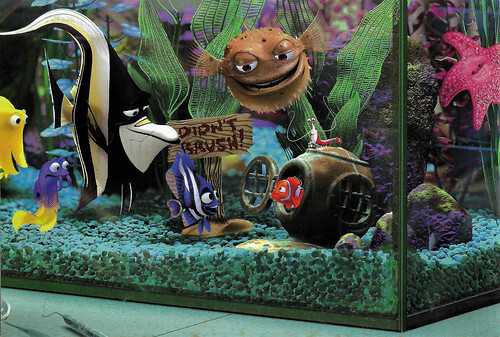
American postcard by Disney Enterprises / Pixar Animation Studios, 2005. Image: Pixar Animation Studios. Film image of Finding Nemo (Andrew Stanton, Lee Unkrich, 2003). From 'The Art of Pixar: 100 Collectible Postcards', published by Chronicle Books.
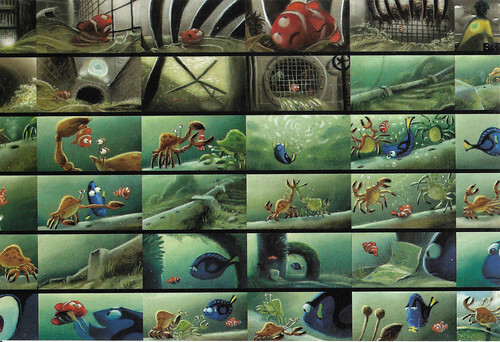
American postcard by Disney Enterprises / Pixar Animation Studios, 2005. Image: Pixar Animation Studios. Concept art by Ralph Eggleston for Finding Nemo (Andrew Stanton, Lee Unkrich, 2003). From 'The Art of Pixar: 100 Collectible Postcards', published by Chronicle Books.
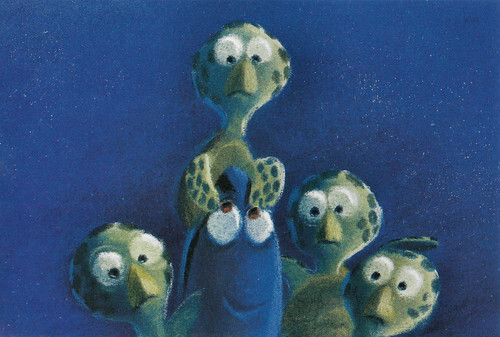
American postcard by Disney Enterprises / Pixar Animation Studios, 2005. Image: Pixar Animation Studios. Concept art by Ralph Eggleston for Finding Nemo (Andrew Stanton, Lee Unkrich, 2003). From 'The Art of Pixar: 100 Collectible Postcards', published by Chronicle Books.
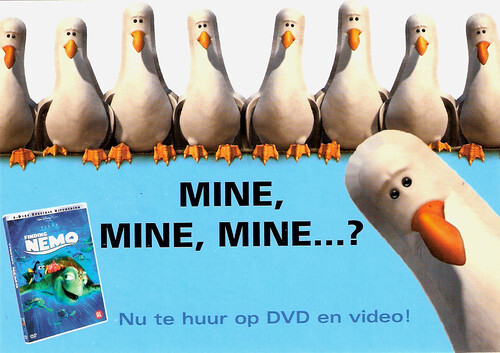
Dutch postcard. Image: Disney / Pixar. Film Image of Finding Nemo (Andrew Stanton, Lee Unkrich, 2003). Caption: Mine, mine, mine...? Now available to rent on DVD and video.
Sources: Wikipedia (Dutch and English), and IMDb.

American postcard by Disney Enterprises / Pixar Animation Studios, 2005. Image: Pixar Animation Studios. Film image of Finding Nemo (Andrew Stanton, Lee Unkrich, 2003). From 'The Art of Pixar: 100 Collectible Postcards', published by Chronicle Books.

French postcard by Sonis, no. C. 1413, offered by Teisseire. Image: Disney / Pixar. Film image of Finding Nemo (Andrew Stanton, Lee Unkrich, 2003).

French postcard by Sonis, no. C. 1414. Image: Disney / Pixar. Film image of Finding Nemo (Andrew Stanton, Lee Unkrich, 2003).

French postcard by Sonis, no. C. 1439. Image: Disney / Pixar. Film image of Finding Nemo (Andrew Stanton, Lee Unkrich, 2003). Caption: Grab shell dude!
An overprotective clownfish called Marlin
At the beginning of Finding Nemo (2003), the clownfish Marlin and his wife Coralie have just moved to a new anemone in the Great Barrier Reef. Their happiness is short-lived as Coralie and almost all the eggs she had laid are devoured by a barracuda. Only one egg survives.
Marlin decides to name the little fish from this egg Nemo, a name that Coralie had thought up. In Latin, the word 'nemo' means 'nobody' or 'no one'. It is also a reference to Captain Nemo in Jules Verne's novel '20,000 Leagues Under the Sea'.
Nemo has one fin that is smaller than normal. His father and he call it Nemo's lucky fin. It is actually a kind of scar from the barracuda's attack. The incident also makes Marlin excessively neurotic and protective of Nemo.
When Nemo is older, it is time for him to go to school. The timid Marlin follows Nemo, against his will, to make absolutely sure he is safe. Nemo has clearly had it with his father's behaviour. To prove there is no danger, he leaves the coral reef. However, he is spotted by two divers. One of them catches Nemo in a net and takes him away.
Marlin gets over his fear of the open sea to retrieve Nemo. He meets Dory, a blue tang suffering from short-term memory loss. One of the divers has lost his goggles, and Marlin finds them. The address of the diver is written on the goggles. With the help of Dory, who can read, they find out that Nemo is in Sydney now.
Dory accompanies Marlin to Sydney on his search for Nemo. The two come across, among other things, three vegetarian sharks, a school of jellyfish, and a group of sea turtles. The latter help them a great deal. Finally, Marlin and Dory are swallowed by a humpback whale that blows them out through the blowhole, which carries them the last mile to Sydney.

American postcard by Disney Enterprises / Pixar Animation Studios, 2005. Image: Pixar Animation Studios. Concept art by Ralph Eggleston for Finding Nemo (Andrew Stanton, Lee Unkrich, 2003). From 'The Art of Pixar: 100 Collectible Postcards', published by Chronicle Books.

American postcard by Disney Enterprises / Pixar Animation Studios, 2005. Image: Pixar Animation Studios. Concept art by Ralph Eggleston for Finding Nemo (Andrew Stanton, Lee Unkrich, 2003). From 'The Art of Pixar: 100 Collectible Postcards', published by Chronicle Books.

American postcard by Disney Enterprises / Pixar Animation Studios, 2005. Image: Pixar Animation Studios. Concept art by Ralph Eggleston for Finding Nemo (Andrew Stanton, Lee Unkrich, 2003). From 'The Art of Pixar: 100 Collectible Postcards', published by Chronicle Books.

American postcard by Disney Enterprises / Pixar Animation Studios, 2005. Image: Pixar Animation Studios. Concept art by Ralph Eggleston for Finding Nemo (Andrew Stanton, Lee Unkrich, 2003). From 'The Art of Pixar: 100 Collectible Postcards', published by Chronicle Books.
One of those rare movies where I wanted to sit in the front row
The inspiration for Finding Nemo (2003) sprang from multiple experiences, going back to director Andrew Stanton's childhood, when he loved going to the dentist to see the fish tank, assuming that the fish were from the ocean and wanted to go home. In 1992, shortly after his son was born, he and his family took a trip to Six Flags Discovery Kingdom which was called Marine World at the time. There, after seeing the shark tube and various exhibits, he felt that the underwater world could be done beautifully in computer animation.
Later, in 1997, he took his son for a walk in the park but realized that he was overprotecting him and lost an opportunity to have a father-son experience that day. In an interview with National Geographic magazine, Stanton said that the idea for the characters of Marlin and Nemo came from a photograph of two clownfish peeking out of an anemone: "It was so arresting. I had no idea what kind of fish they were, but I couldn't take my eyes off them. And as an entertainer, the fact that they were called clownfish - it was perfect. There's almost nothing more appealing than these little fish that want to play peekaboo with you."
In addition, clownfish are colourful, but do not tend to come out of an anemone often. For a character who has to go on a dangerous journey, Stanton felt a clownfish was the perfect type of fish for the character. Pre-production of the film began in early 1997. Stanton began writing the screenplay during the post-production of A Bug's Life (John Lasseter, Andrew Stanton, 1998). As a result, Finding Nemo began production with a complete screenplay, something that co-director Lee Unkrich called "very unusual for an animated film".
The artists took scuba diving lessons to study the coral reef. Stanton originally planned to use flashbacks to reveal how Coral died but realized that by the end of the film there would be nothing to reveal, deciding to show how she died at the beginning of the film. Finding Nemo was the first Pixar film not to be scored by Randy Newman. The original soundtrack album, 'Finding Nemo,' was scored by Thomas Newman, his cousin. The score was nominated for the Academy Award for Original Score, losing to The Lord of the Rings: The Return of the King (Peter Jackson, 2003).
Finding Nemo (2003) did win the Academy Award for Best Animated Feature, the first Pixar film to do so. It was also nominated in two more categories, including Best Original Screenplay. Roger Ebert gave the film four out of four stars, calling it "one of those rare movies where I wanted to sit in the front row and let the images wash out to the edges of my field of vision".
Finding Nemo became the highest-grossing animated film at the time of its release, and was the second-highest-grossing film of 2003, earning a total of $871 million worldwide by the end of its initial theatrical run. Demand for tropical fish exploded right after the film's release, especially for clownfish and blue tang. Finding Nemo is also the best-selling DVD title of all time, with over 40 million copies sold as of 2006. After the success of the 3D re-release of The Lion King (Roger Allers, Rob Minkoff, 1994), Disney re-released Finding Nemo in 3D in 2012. A spin-off sequel, Finding Dory (Andrew Stanton, Angus MacLane, 2016), was released in June 2016.

American postcard by Disney Enterprises / Pixar Animation Studios, 2005. Image: Pixar Animation Studios. Film image of Finding Nemo (Andrew Stanton, Lee Unkrich, 2003). From 'The Art of Pixar: 100 Collectible Postcards', published by Chronicle Books.

American postcard by Disney Enterprises / Pixar Animation Studios, 2005. Image: Pixar Animation Studios. Concept art by Ralph Eggleston for Finding Nemo (Andrew Stanton, Lee Unkrich, 2003). From 'The Art of Pixar: 100 Collectible Postcards', published by Chronicle Books.

American postcard by Disney Enterprises / Pixar Animation Studios, 2005. Image: Pixar Animation Studios. Concept art by Ralph Eggleston for Finding Nemo (Andrew Stanton, Lee Unkrich, 2003). From 'The Art of Pixar: 100 Collectible Postcards', published by Chronicle Books.

Dutch postcard. Image: Disney / Pixar. Film Image of Finding Nemo (Andrew Stanton, Lee Unkrich, 2003). Caption: Mine, mine, mine...? Now available to rent on DVD and video.
Sources: Wikipedia (Dutch and English), and IMDb.
Published on January 16, 2022 22:00
January 15, 2022
In memory of Jean-Jacques Beineix (1946-2022): 37°2 le matin / Betty Blue (1986)
On 13 January 2022, the French director, screenwriter and producer Jean-Jacques Beineix (1946) died in Paris. His first feature film, the psychological thriller Diva (1980), about a young postman obsessed with an opera diva, received four Césars. An even bigger success was his third film, 37°2 le matin/Betty Blue (1986). The erotic drama was nominated for the best foreign-language film at the Oscars and became the eighth highest-grossing film of the year in France. Beineix, who suffered from leukaemia. was 75. In his memory, EFSP presents a post on his best-known film, the sensational 37°2 le matin/Betty Blue (1986).
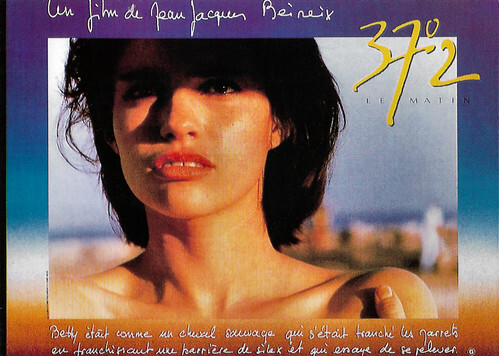
French postcard by Humour a la carte, Paris, no. A-C 1242. Photo: Gaumont. Béatrice Dalle in 37°2 le matin/Betty Blue (Jean-Jacques Beineix, 1986). Caption: Betty was like a wild horse that had cut its nostrils on a fence and was trying to get back up.
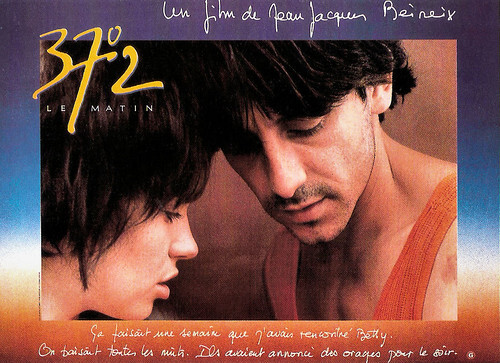
French postcard by Humour a la carte, Paris, no. A-C 1244. Photo: Gaumont. Béatrice Dalle and Jean-Hugues Anglade in 37°2 le matin/Betty Blue (Jean-Jacques Beineix, 1986). Caption: It had been a week since I met Betty. We had sex every night. They had announced thunderstorms for the evening.
Non-naturalistic, self-conscious aesthetics, notably intense colours and lighting effects
Jean-Jacques Beineix, born in Paris in 1946, was a rabid movie fan when he was young. He trained as a doctor but began his career as Jean Becker's assistant director on the popular French TV series Les Saintes chéries/The darling saints (1970-1971). In 1970, he worked for director Claude Berri and, the following year, for Claude Zidi. He was also hired as an assistant director on Jerry Lewis ' unreleased film, The Day the Clown Cried (1972).
In 1977, Beineix directed his first short film, Le Chien de M. Michel/Mr. Michel's Dog (1977), The film, which won first prize at the Trouville Festival, is interesting while it has some of the great imagery and pathos that would define some of Beineix's later work. In 1980, Beineix directed his first feature film, Diva, starring Wilhelmenia Wiggins Fernandez and Frédéric Andréi, which was a big commercial success and received four Césars. The film was also entered in the 12th Moscow International Film Festival.
His second feature was the drama La Lune dans le caniveau/Moon in the Gutter (1983). It featured two big stars, Gérard Depardieu and Nastassia Kinski , was nominated for the Palme d'Or at the 1983 Cannes Festival and nominated for three Césars in 1984. However, it would win only one César in the Best Production Design category. The Moon in the Gutter was not well received by critics or audiences and failed at the box office with only 625,000 admissions in France.
In 1984 Jean-Jacques Beineix created his own production company, Cargo Films, in order to retain his artistic independence. The first production was 37°2 le matin/Betty Blue (Jean-Jacques Beineix, 1986) in which Béatrice Dalle - in her debut film - and Jean-Hugues Anglade starred. The erotic psychological drama, based on the 1985 novel of the same name by Philippe Djian, was the eighth highest-grossing film of the year in France. In 1987, it was nominated for the Best Foreign Language Film Oscar, in the same category as that year’s British Academy Film Awards and Golden Globes. It also received the Best Poster Award, one of nine Césars for which it was nominated.
Beineix became executive producer of all the Cargo projects, feature films and documentaries. He directed the features Roselyne et les lions/Roselyne and the Lions (1989), IP5: L'île aux pachydermes/IP5: The Island of Pachyderms (1992) with Yves Montand in his last role, and Mortel Transfert (2001), starring Jean-Hugues Anglade . Cargo produced documentaries on a wide variety of themes from science to art, to women’s rights and social problems. Several works have been made in partnership with national scientific organisations such as CNES and CNRS. Beineix directed e.g. a corporate film for CNRS, 2 infinities (L2i) (2008), which was shown at the 2008 New York Imagine Science film festival. In late 2006, Beineix published the first volume of his autobiography, 'Les Chantiers de la gloire' (in French only).
Jean Jacques Beineix passed away at home in Paris after a long illness in 2022, at the age of 75. His work is often seen as a prime example of the so-called 'Cinéma du look'. Film critic Ginette Vincendeau has defined the films made by Beineix, Luc Besson and Léos Carax as "youth-oriented films with high production values... The look of the Cinéma du look refers to the films' high investment in non-naturalistic, self-conscious aesthetics, notably intense colours and lighting effects. Their spectacular (studio-based) and technically brilliant mise-en-scène is usually put to the service of romantic plots." Besson en Beineix were much maligned by film critics during the 1980s, while Carax was much admired. In 2020, Beineix said that he “never got over” being booed at the premiere of La Lune dans le caniveau/Moon in the Gutter at the Cannes film festival in 1983. “The hurt is there. The fact that I am finished today started there”.
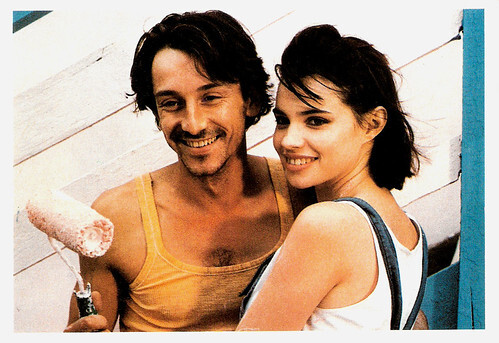
French postcard by Ebulittions, no. 16. Photo: publicity still for 37°2 le matin/Betty Blue (1986).
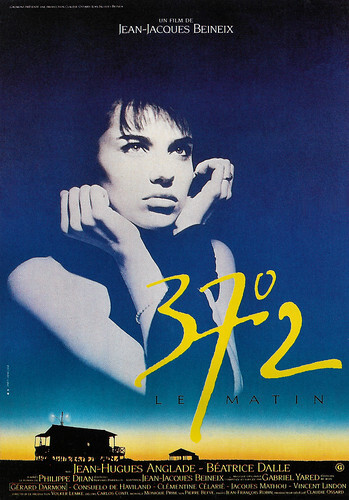
French postcard by Editions F. Nugeron, no. E 309. Image: French film poster for 37°2 le matin/Betty Blue (Jean-Jacques Beineix, 1986).
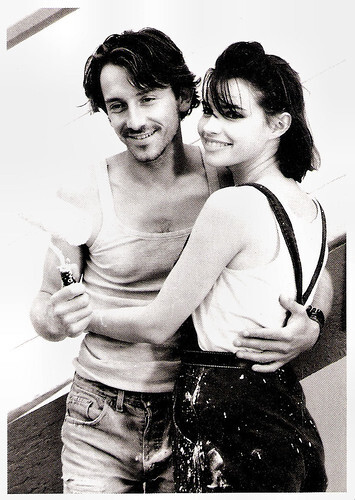
French postcard by Especially for you, Réf. 6. Photo: Jean-Hugues Anglade and Béatrice Dalle in 37°2 le matin/Betty Blue (1986).
The obsessive love of a young couple
There are two versions of 37° 2 le matin (37.2°C (98.6°F) in the morning): the original version of around two hours and the director's cut which is over three hours long and contains considerably more scenes. Beineix's film depicts the obsessive love of a young couple, Betty and Zorg. Zorg ( Jean-Hugues Anglade ) is a thirtysomething aspiring writer, who is making a quiet living as a handyman for a community of beach houses in the seaside resort at Gruissan on France's Mediterranean coast. He meets 19-year-old Betty ( Béatrice Dalle ), who is as beautiful as she is wild and unpredictable. The two begin a passionate affair and live in his borrowed shack on the beach. Following a row with him where she tears apart and smashes up the house, she finds the manuscript of his first novel; she reads it in one long sitting and decides he is a genius. However, after another argument with his boss, she empties the shack and burns it down.
The film is divided into several "chapters" in which Zorg searches for a place in France for himself and Betty, where they repeatedly try to live and work. The two decamp to the outskirts of Paris, where her friend Lisa (Consuelo de Haviland) has a small hotel. Betty laboriously types out Zorg's novel and submits it to various publishers. They meet Lisa's new boyfriend Eddy (Gérard Darmon), and the four have many fun times, often fuelled by alcohol. They find work in Eddy's pizzeria, but a fight erupts in which Betty stabs a customer with a fork. Zorg tries to slap her back to her senses.
Though Zorg hides the rejection letters, Betty finds one and, going to the publisher's house, slashes his face. Zorg induces him to drop charges by threatening him with violence, saying she is the only good thing in his life and she is all he has. But Betty's violent mood swings are a concern. Eddy's mother dies and the friends go to the funeral in Marvejols. There, Eddy asks Zorg and Betty if they will live in the dead woman's house and look after her piano shop. Zorg enjoys the quiet provincial life and makes friends with the grocer Bob (Jacques Mathou), his sex-starved wife Annie (Clémentine Célarié), and various offbeat characters.
Betty's wild manners start to get out of control and Zorg sees the woman he loves slowly going insane. After an irritating comment from Zorg, she punches out a window with her bare hand and goes on a screaming flight through the town. Happiness seems on the horizon when a home test suggests Betty is pregnant. The film title 37° 2 le matin/37.2 degrees in the morning alludes to increased body temperature as a possible sign of pregnancy. When a lab test is negative, Betty sinks into depression and tells him she is hearing voices talking to her in her head. Zorg, masquerading as a woman, robs an armoured cash collection van delivery headquarters, holding the guards at gunpoint, and tying them up. He attempts to use the money to buy Betty's happiness, but she fails to respond and enacts yet another prosecutable offence by luring a small boy away from his mother and taking him to a toy store. Zorg finds her and they both flee from the authorities as they rush to rescue the boy.
One day, Zorg comes home to find blood all over the place and Betty is gone. Bob tells him she has gouged out an eye and is in the hospital. Rushing there, Zorg finds her under heavy sedation and is told to come back the next day. Going home, he receives a phone call from a publisher accepting his manuscript. On his next visit to the hospital, he finds Betty restrained and catatonic. He becomes agitated and a doctor tells him she will need prolonged treatment and may never recover her sanity. Zorg reacts by blaming her illness on the medication being administered and physically attacks the doctor. He is forcefully ejected from the hospital after a violent struggle with three orderlies. Returning in disguise, he whispers his farewells and smothers Betty with a pillow. Going home, he sits down to continue his current book.
The action of the film is portrayed from Zorg's point of view and often commented on off-screen. Bound together by loneliness, a bleak existence and a strong sexual attraction, Betty and Zorg create a world in which only the two of them have a place. Other characters only appear in passing. The focus is on the two main characters and their attempt to escape their own desolation with the help of the other.
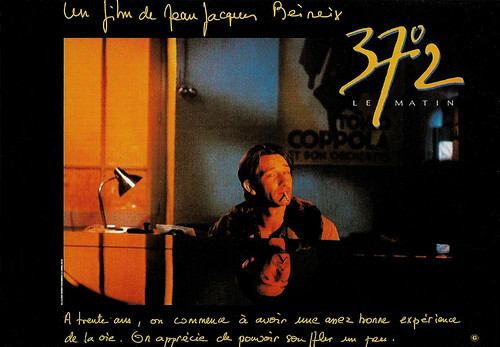
French postcard by Humour a la carte, Paris, no. A-C 1241. Photo: Gaumont. Jean-Hugues Anglade in 37°2 le matin/Betty Blue (Jean-Jacques Beineix, 1986). Caption: At thirty, you start to have a pretty good experience of life. You appreciate being able to breathe a little.
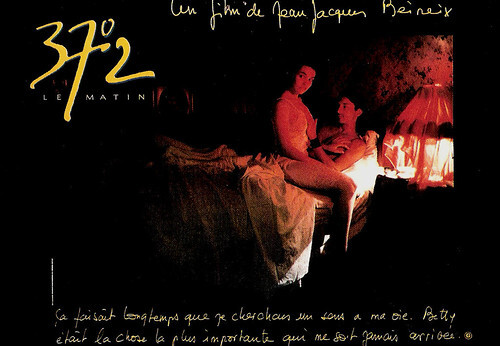
French postcard by Humour a la carte, Paris, no. A-C 1243. Photo: Gaumont. Béatrice Dalle and Jean-Hugues Anglade in 37°2 le matin/Betty Blue (Jean-Jacques Beineix, 1986). Caption: I had been looking for meaning in my life for a long time. Betty was the most important thing that ever happened to me.
Sources: (IMDb), Wikipedia (English and German), and .

French postcard by Humour a la carte, Paris, no. A-C 1242. Photo: Gaumont. Béatrice Dalle in 37°2 le matin/Betty Blue (Jean-Jacques Beineix, 1986). Caption: Betty was like a wild horse that had cut its nostrils on a fence and was trying to get back up.

French postcard by Humour a la carte, Paris, no. A-C 1244. Photo: Gaumont. Béatrice Dalle and Jean-Hugues Anglade in 37°2 le matin/Betty Blue (Jean-Jacques Beineix, 1986). Caption: It had been a week since I met Betty. We had sex every night. They had announced thunderstorms for the evening.
Non-naturalistic, self-conscious aesthetics, notably intense colours and lighting effects
Jean-Jacques Beineix, born in Paris in 1946, was a rabid movie fan when he was young. He trained as a doctor but began his career as Jean Becker's assistant director on the popular French TV series Les Saintes chéries/The darling saints (1970-1971). In 1970, he worked for director Claude Berri and, the following year, for Claude Zidi. He was also hired as an assistant director on Jerry Lewis ' unreleased film, The Day the Clown Cried (1972).
In 1977, Beineix directed his first short film, Le Chien de M. Michel/Mr. Michel's Dog (1977), The film, which won first prize at the Trouville Festival, is interesting while it has some of the great imagery and pathos that would define some of Beineix's later work. In 1980, Beineix directed his first feature film, Diva, starring Wilhelmenia Wiggins Fernandez and Frédéric Andréi, which was a big commercial success and received four Césars. The film was also entered in the 12th Moscow International Film Festival.
His second feature was the drama La Lune dans le caniveau/Moon in the Gutter (1983). It featured two big stars, Gérard Depardieu and Nastassia Kinski , was nominated for the Palme d'Or at the 1983 Cannes Festival and nominated for three Césars in 1984. However, it would win only one César in the Best Production Design category. The Moon in the Gutter was not well received by critics or audiences and failed at the box office with only 625,000 admissions in France.
In 1984 Jean-Jacques Beineix created his own production company, Cargo Films, in order to retain his artistic independence. The first production was 37°2 le matin/Betty Blue (Jean-Jacques Beineix, 1986) in which Béatrice Dalle - in her debut film - and Jean-Hugues Anglade starred. The erotic psychological drama, based on the 1985 novel of the same name by Philippe Djian, was the eighth highest-grossing film of the year in France. In 1987, it was nominated for the Best Foreign Language Film Oscar, in the same category as that year’s British Academy Film Awards and Golden Globes. It also received the Best Poster Award, one of nine Césars for which it was nominated.
Beineix became executive producer of all the Cargo projects, feature films and documentaries. He directed the features Roselyne et les lions/Roselyne and the Lions (1989), IP5: L'île aux pachydermes/IP5: The Island of Pachyderms (1992) with Yves Montand in his last role, and Mortel Transfert (2001), starring Jean-Hugues Anglade . Cargo produced documentaries on a wide variety of themes from science to art, to women’s rights and social problems. Several works have been made in partnership with national scientific organisations such as CNES and CNRS. Beineix directed e.g. a corporate film for CNRS, 2 infinities (L2i) (2008), which was shown at the 2008 New York Imagine Science film festival. In late 2006, Beineix published the first volume of his autobiography, 'Les Chantiers de la gloire' (in French only).
Jean Jacques Beineix passed away at home in Paris after a long illness in 2022, at the age of 75. His work is often seen as a prime example of the so-called 'Cinéma du look'. Film critic Ginette Vincendeau has defined the films made by Beineix, Luc Besson and Léos Carax as "youth-oriented films with high production values... The look of the Cinéma du look refers to the films' high investment in non-naturalistic, self-conscious aesthetics, notably intense colours and lighting effects. Their spectacular (studio-based) and technically brilliant mise-en-scène is usually put to the service of romantic plots." Besson en Beineix were much maligned by film critics during the 1980s, while Carax was much admired. In 2020, Beineix said that he “never got over” being booed at the premiere of La Lune dans le caniveau/Moon in the Gutter at the Cannes film festival in 1983. “The hurt is there. The fact that I am finished today started there”.

French postcard by Ebulittions, no. 16. Photo: publicity still for 37°2 le matin/Betty Blue (1986).

French postcard by Editions F. Nugeron, no. E 309. Image: French film poster for 37°2 le matin/Betty Blue (Jean-Jacques Beineix, 1986).

French postcard by Especially for you, Réf. 6. Photo: Jean-Hugues Anglade and Béatrice Dalle in 37°2 le matin/Betty Blue (1986).
The obsessive love of a young couple
There are two versions of 37° 2 le matin (37.2°C (98.6°F) in the morning): the original version of around two hours and the director's cut which is over three hours long and contains considerably more scenes. Beineix's film depicts the obsessive love of a young couple, Betty and Zorg. Zorg ( Jean-Hugues Anglade ) is a thirtysomething aspiring writer, who is making a quiet living as a handyman for a community of beach houses in the seaside resort at Gruissan on France's Mediterranean coast. He meets 19-year-old Betty ( Béatrice Dalle ), who is as beautiful as she is wild and unpredictable. The two begin a passionate affair and live in his borrowed shack on the beach. Following a row with him where she tears apart and smashes up the house, she finds the manuscript of his first novel; she reads it in one long sitting and decides he is a genius. However, after another argument with his boss, she empties the shack and burns it down.
The film is divided into several "chapters" in which Zorg searches for a place in France for himself and Betty, where they repeatedly try to live and work. The two decamp to the outskirts of Paris, where her friend Lisa (Consuelo de Haviland) has a small hotel. Betty laboriously types out Zorg's novel and submits it to various publishers. They meet Lisa's new boyfriend Eddy (Gérard Darmon), and the four have many fun times, often fuelled by alcohol. They find work in Eddy's pizzeria, but a fight erupts in which Betty stabs a customer with a fork. Zorg tries to slap her back to her senses.
Though Zorg hides the rejection letters, Betty finds one and, going to the publisher's house, slashes his face. Zorg induces him to drop charges by threatening him with violence, saying she is the only good thing in his life and she is all he has. But Betty's violent mood swings are a concern. Eddy's mother dies and the friends go to the funeral in Marvejols. There, Eddy asks Zorg and Betty if they will live in the dead woman's house and look after her piano shop. Zorg enjoys the quiet provincial life and makes friends with the grocer Bob (Jacques Mathou), his sex-starved wife Annie (Clémentine Célarié), and various offbeat characters.
Betty's wild manners start to get out of control and Zorg sees the woman he loves slowly going insane. After an irritating comment from Zorg, she punches out a window with her bare hand and goes on a screaming flight through the town. Happiness seems on the horizon when a home test suggests Betty is pregnant. The film title 37° 2 le matin/37.2 degrees in the morning alludes to increased body temperature as a possible sign of pregnancy. When a lab test is negative, Betty sinks into depression and tells him she is hearing voices talking to her in her head. Zorg, masquerading as a woman, robs an armoured cash collection van delivery headquarters, holding the guards at gunpoint, and tying them up. He attempts to use the money to buy Betty's happiness, but she fails to respond and enacts yet another prosecutable offence by luring a small boy away from his mother and taking him to a toy store. Zorg finds her and they both flee from the authorities as they rush to rescue the boy.
One day, Zorg comes home to find blood all over the place and Betty is gone. Bob tells him she has gouged out an eye and is in the hospital. Rushing there, Zorg finds her under heavy sedation and is told to come back the next day. Going home, he receives a phone call from a publisher accepting his manuscript. On his next visit to the hospital, he finds Betty restrained and catatonic. He becomes agitated and a doctor tells him she will need prolonged treatment and may never recover her sanity. Zorg reacts by blaming her illness on the medication being administered and physically attacks the doctor. He is forcefully ejected from the hospital after a violent struggle with three orderlies. Returning in disguise, he whispers his farewells and smothers Betty with a pillow. Going home, he sits down to continue his current book.
The action of the film is portrayed from Zorg's point of view and often commented on off-screen. Bound together by loneliness, a bleak existence and a strong sexual attraction, Betty and Zorg create a world in which only the two of them have a place. Other characters only appear in passing. The focus is on the two main characters and their attempt to escape their own desolation with the help of the other.

French postcard by Humour a la carte, Paris, no. A-C 1241. Photo: Gaumont. Jean-Hugues Anglade in 37°2 le matin/Betty Blue (Jean-Jacques Beineix, 1986). Caption: At thirty, you start to have a pretty good experience of life. You appreciate being able to breathe a little.

French postcard by Humour a la carte, Paris, no. A-C 1243. Photo: Gaumont. Béatrice Dalle and Jean-Hugues Anglade in 37°2 le matin/Betty Blue (Jean-Jacques Beineix, 1986). Caption: I had been looking for meaning in my life for a long time. Betty was the most important thing that ever happened to me.
Sources: (IMDb), Wikipedia (English and German), and .
Published on January 15, 2022 22:00
Paul van Yperen's Blog
- Paul van Yperen's profile
- 13 followers
Paul van Yperen isn't a Goodreads Author
(yet),
but they
do have a blog,
so here are some recent posts imported from
their feed.



